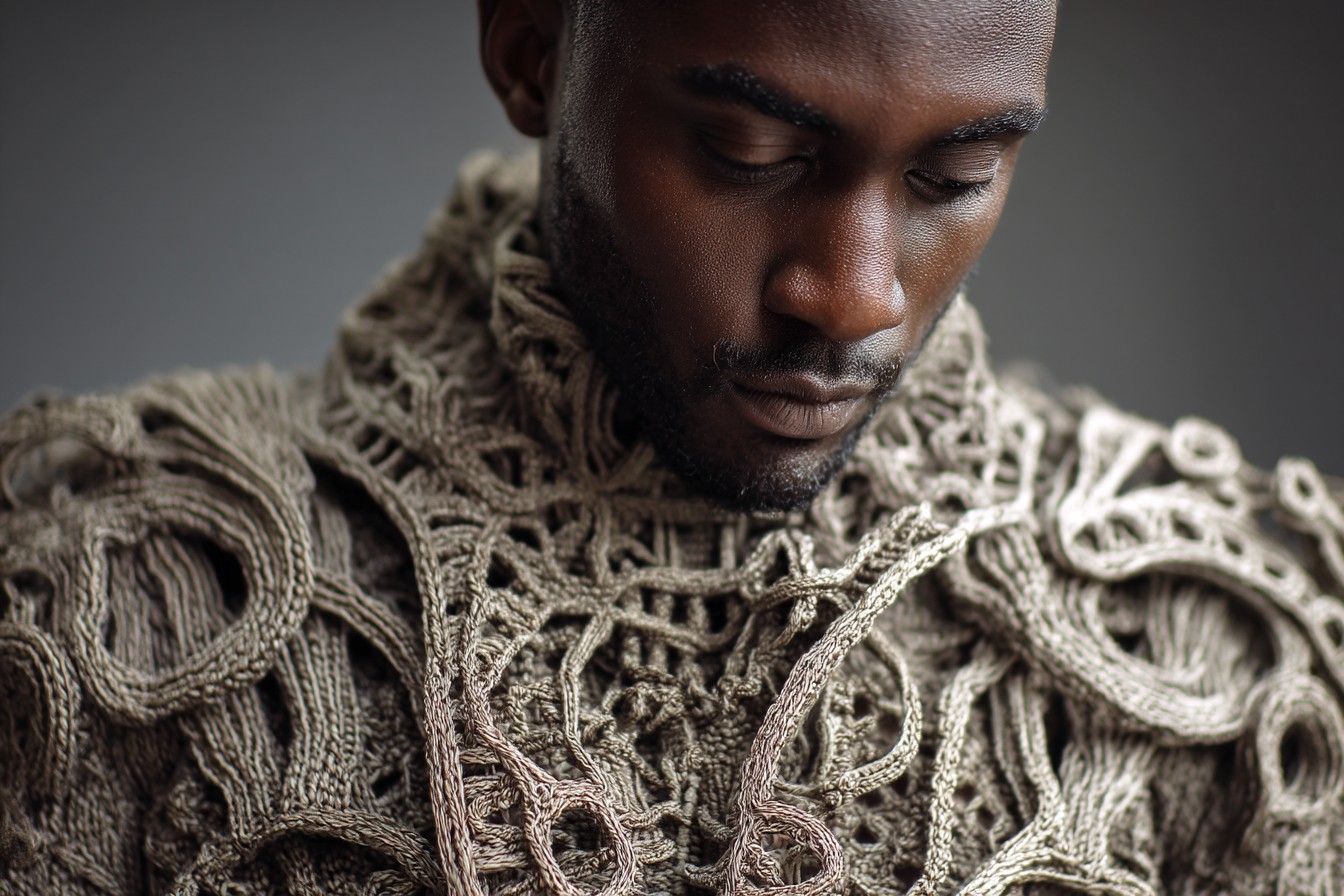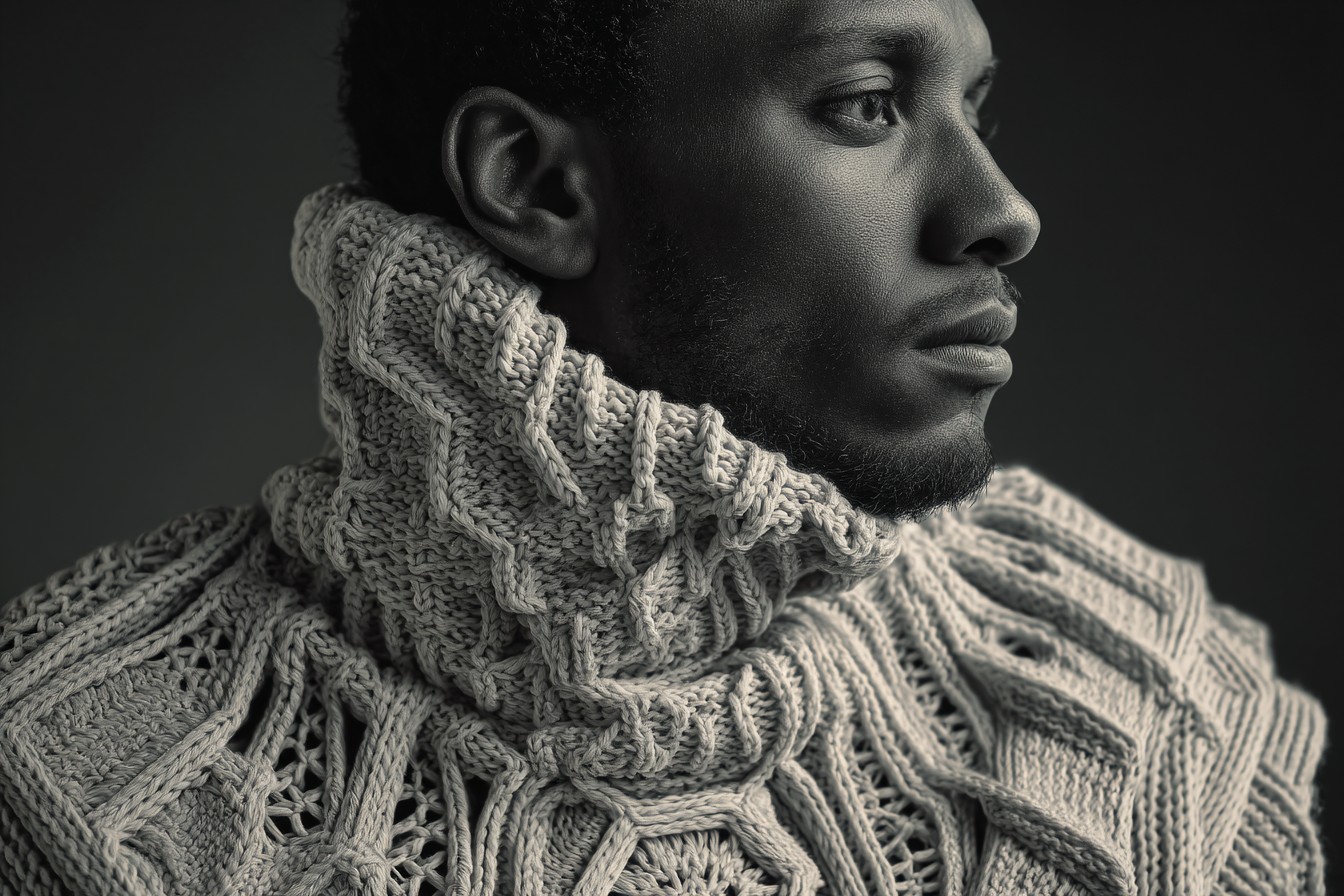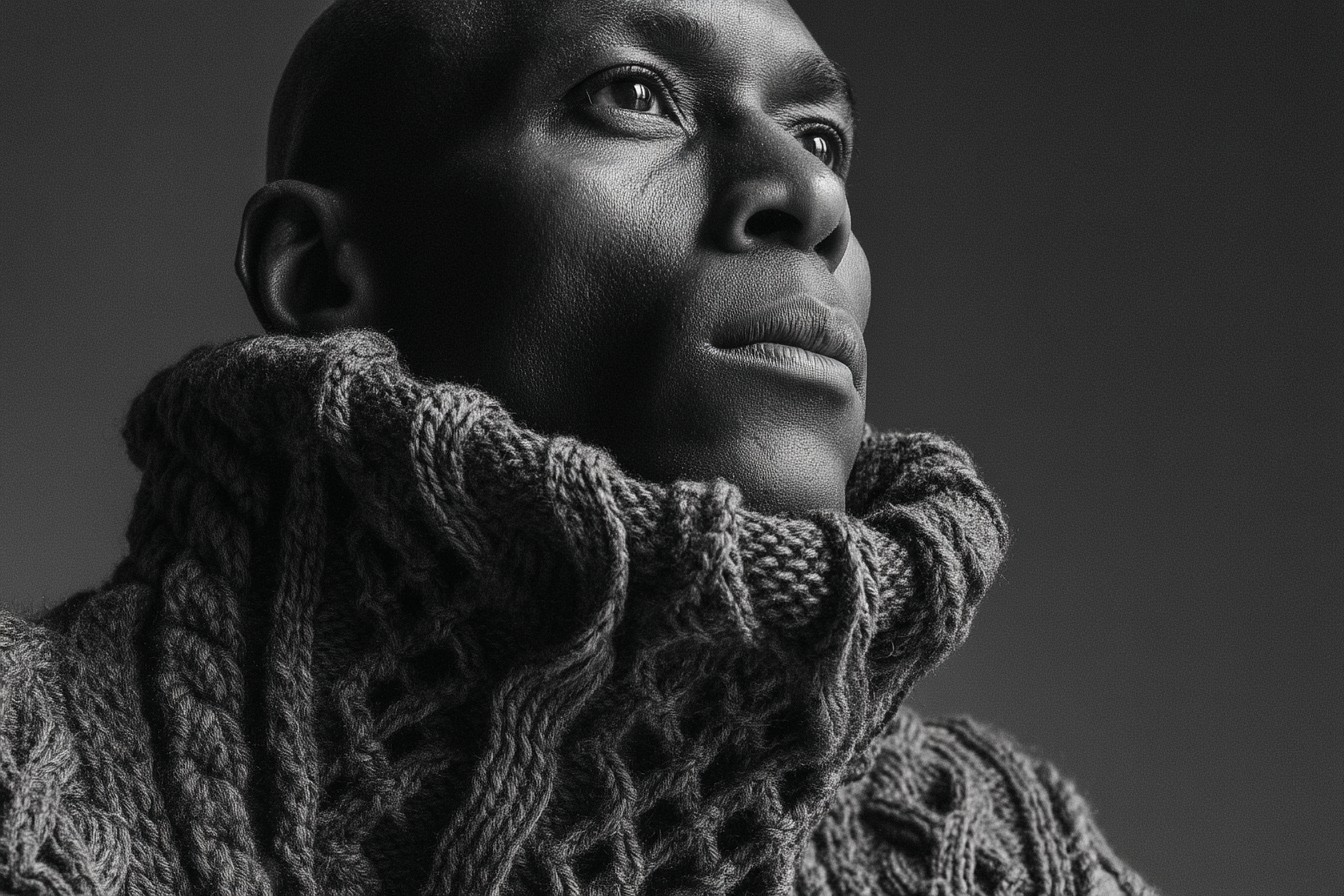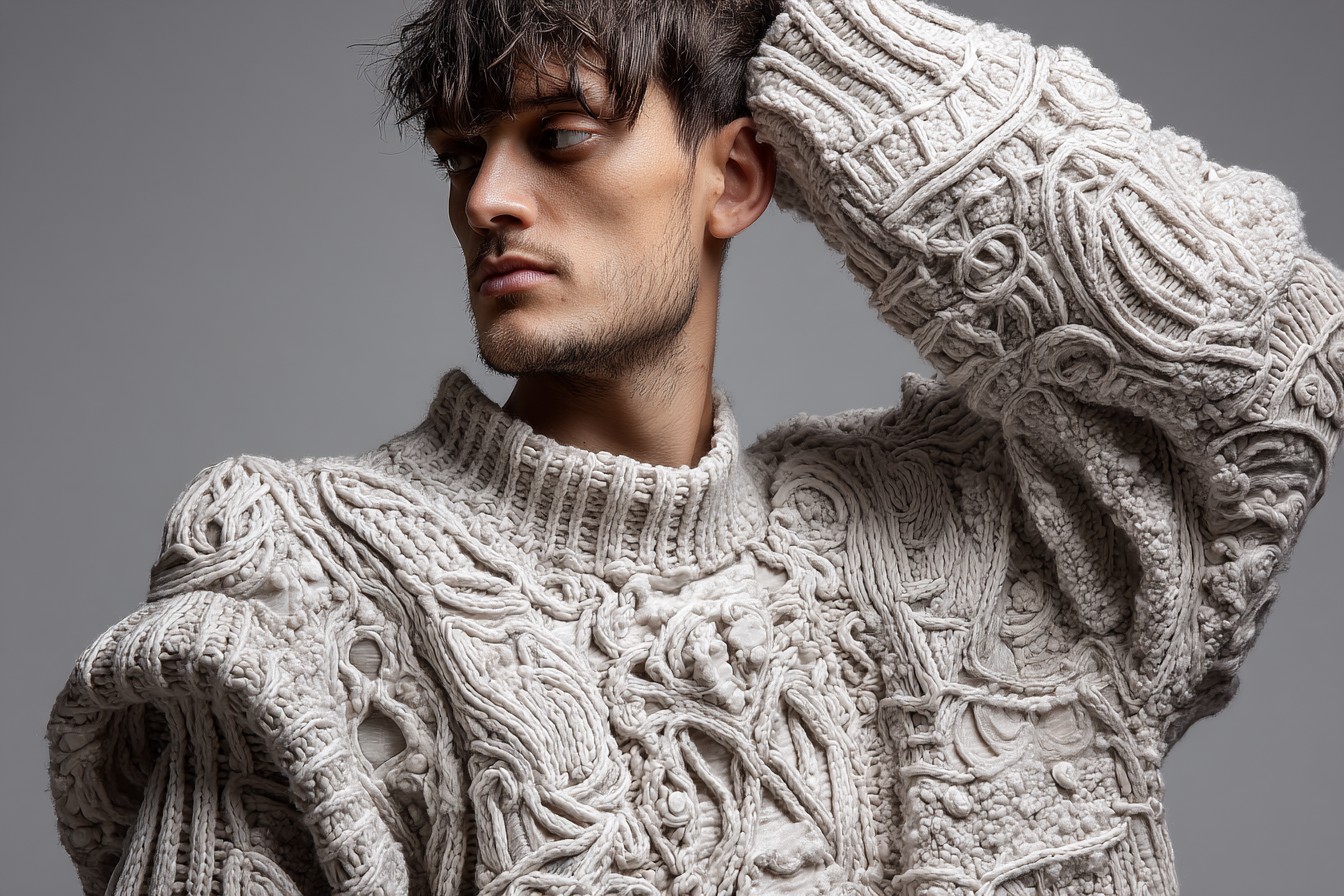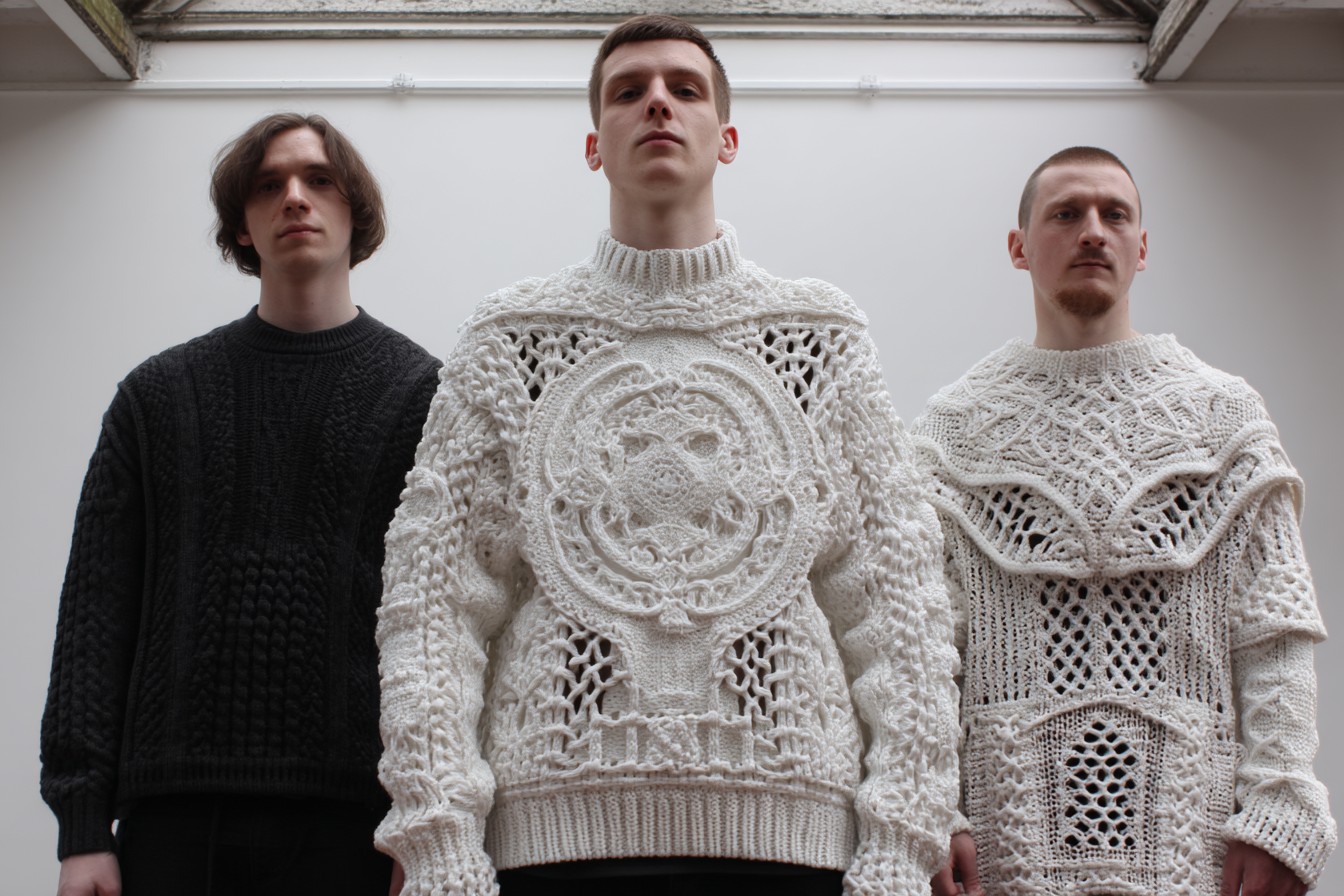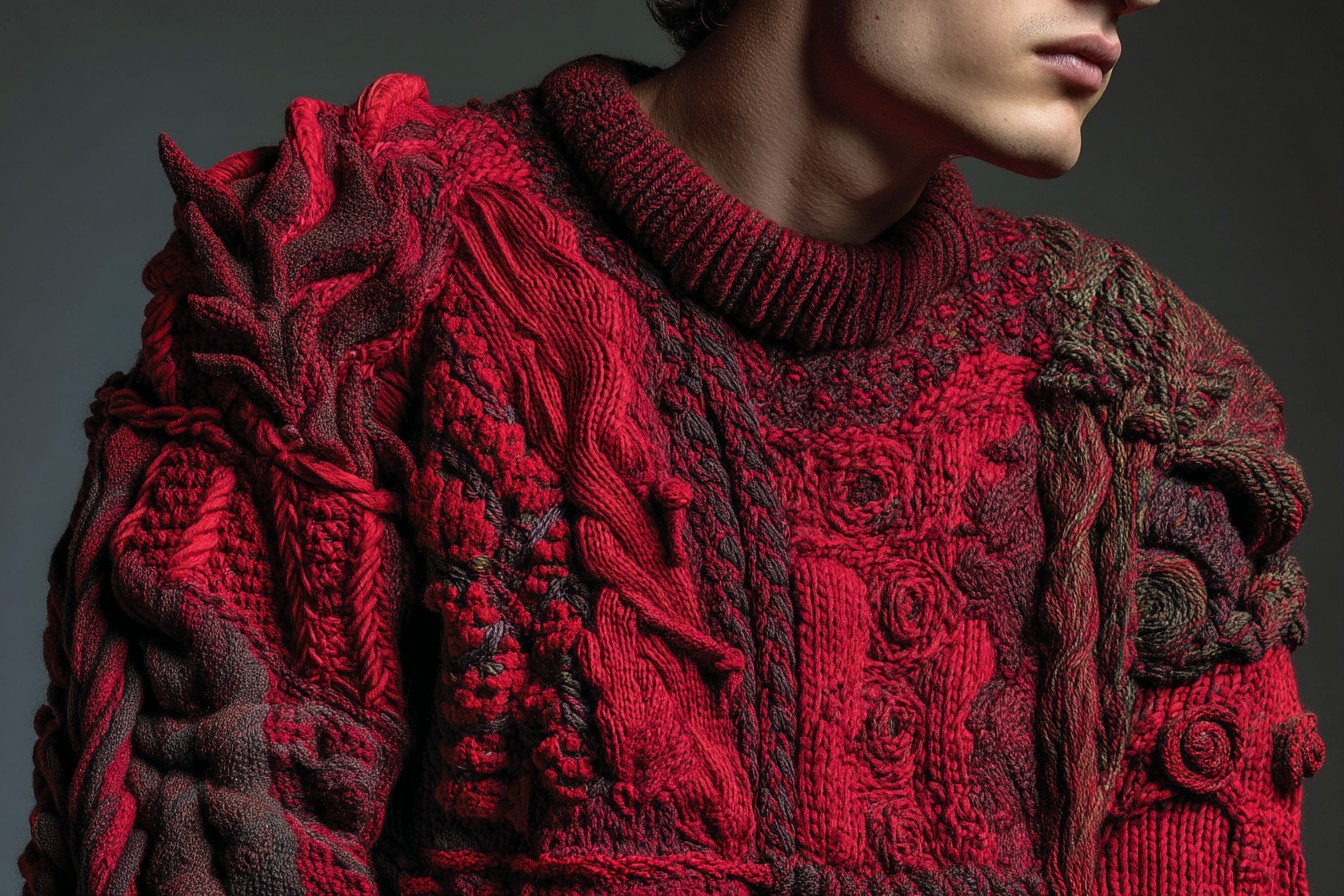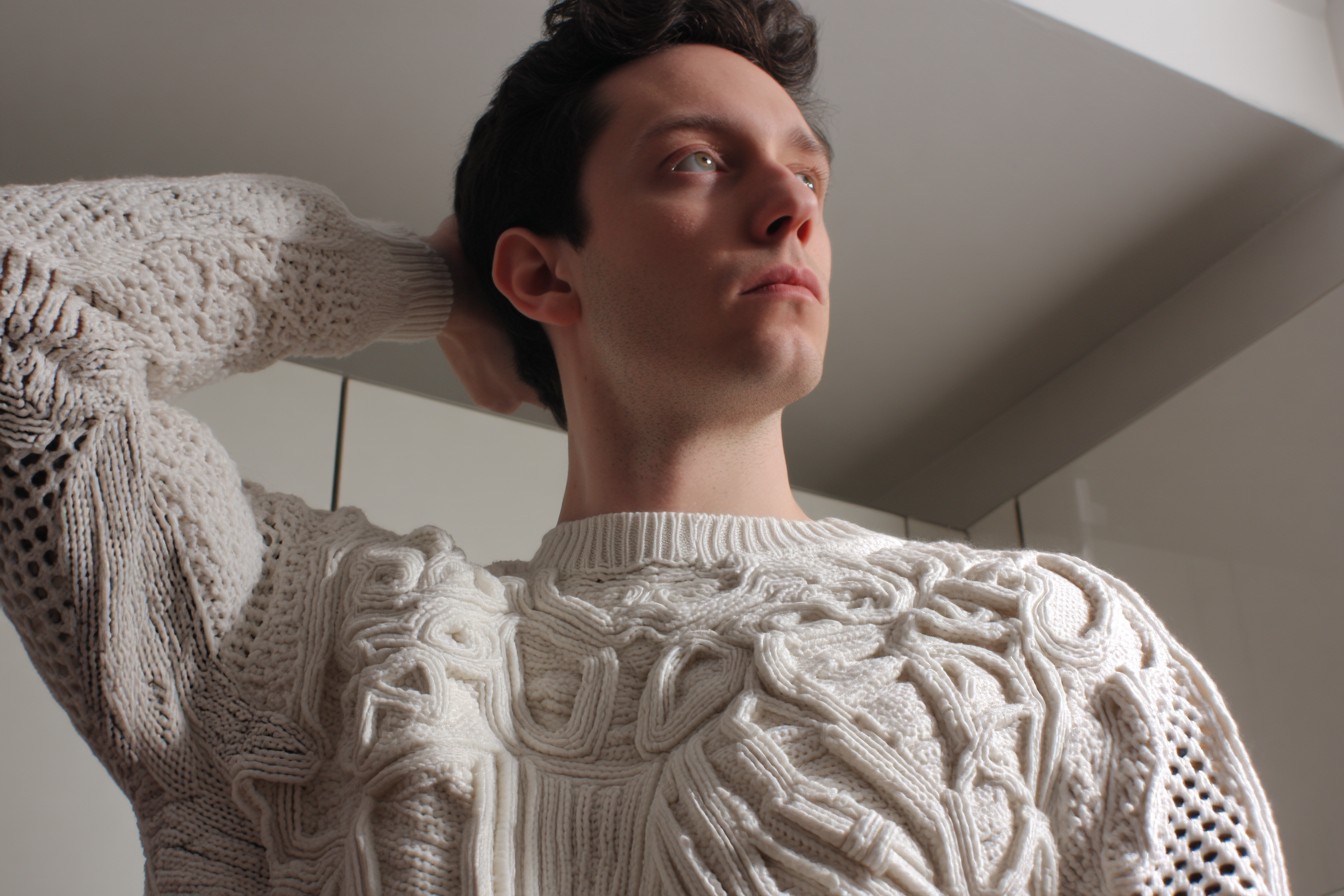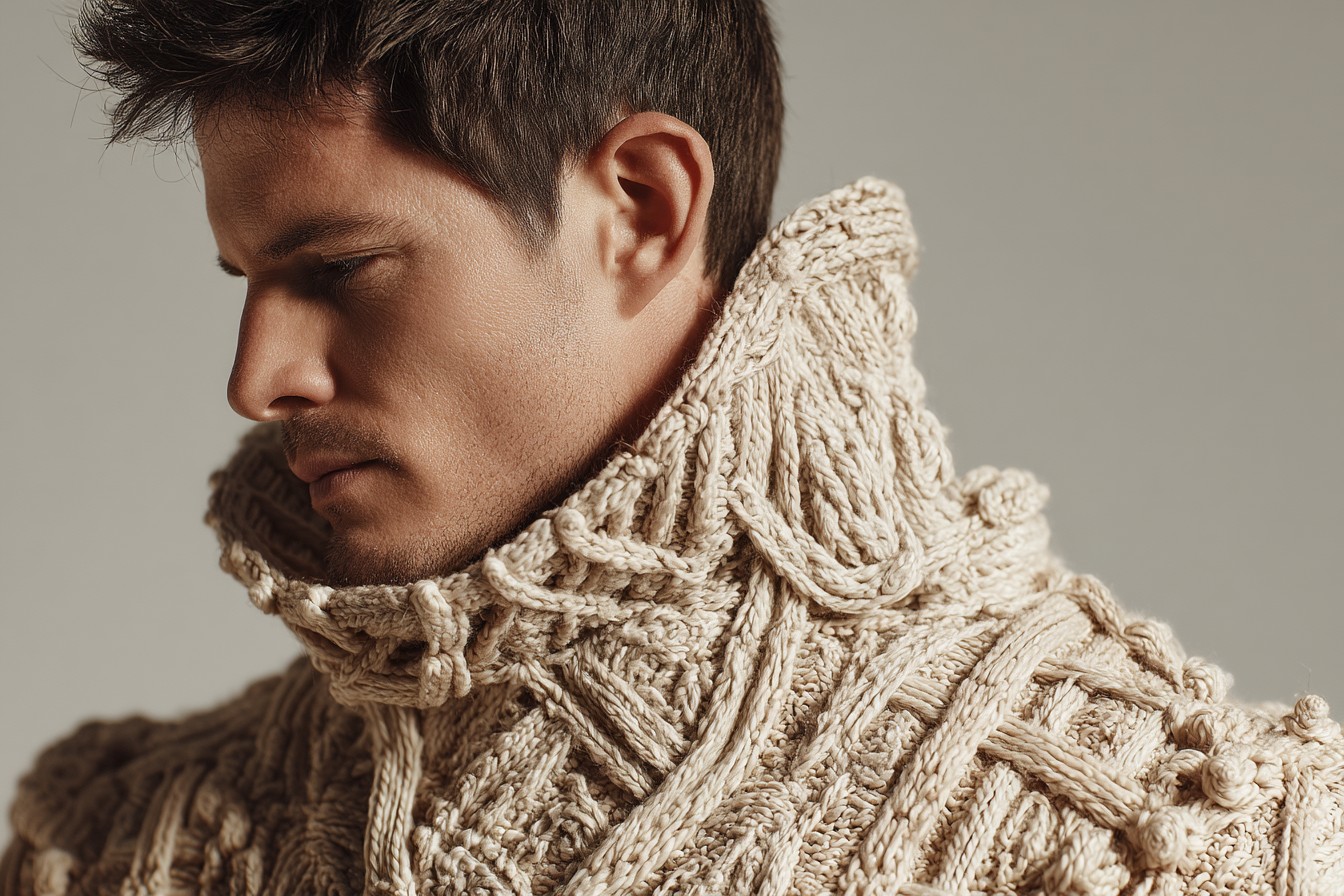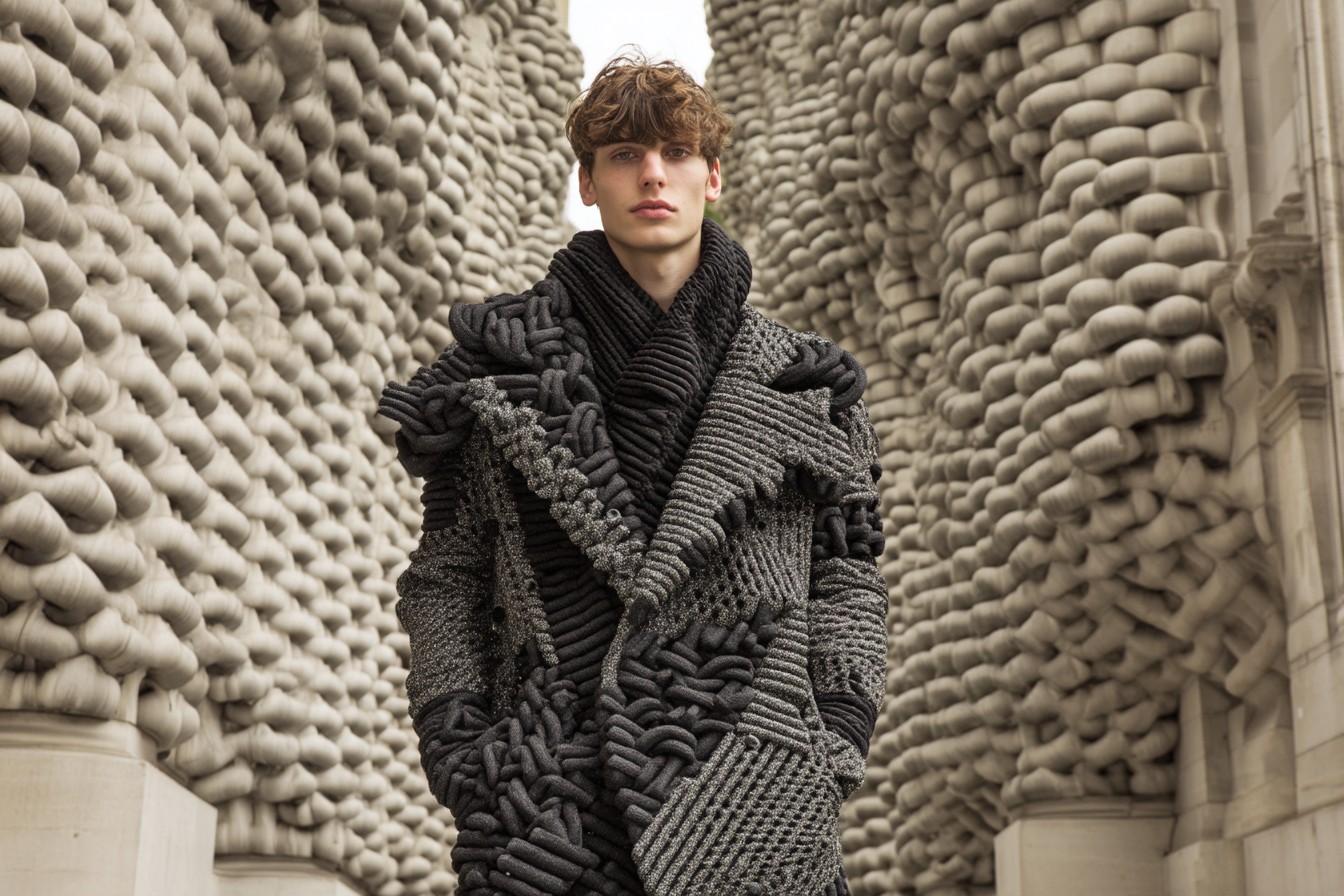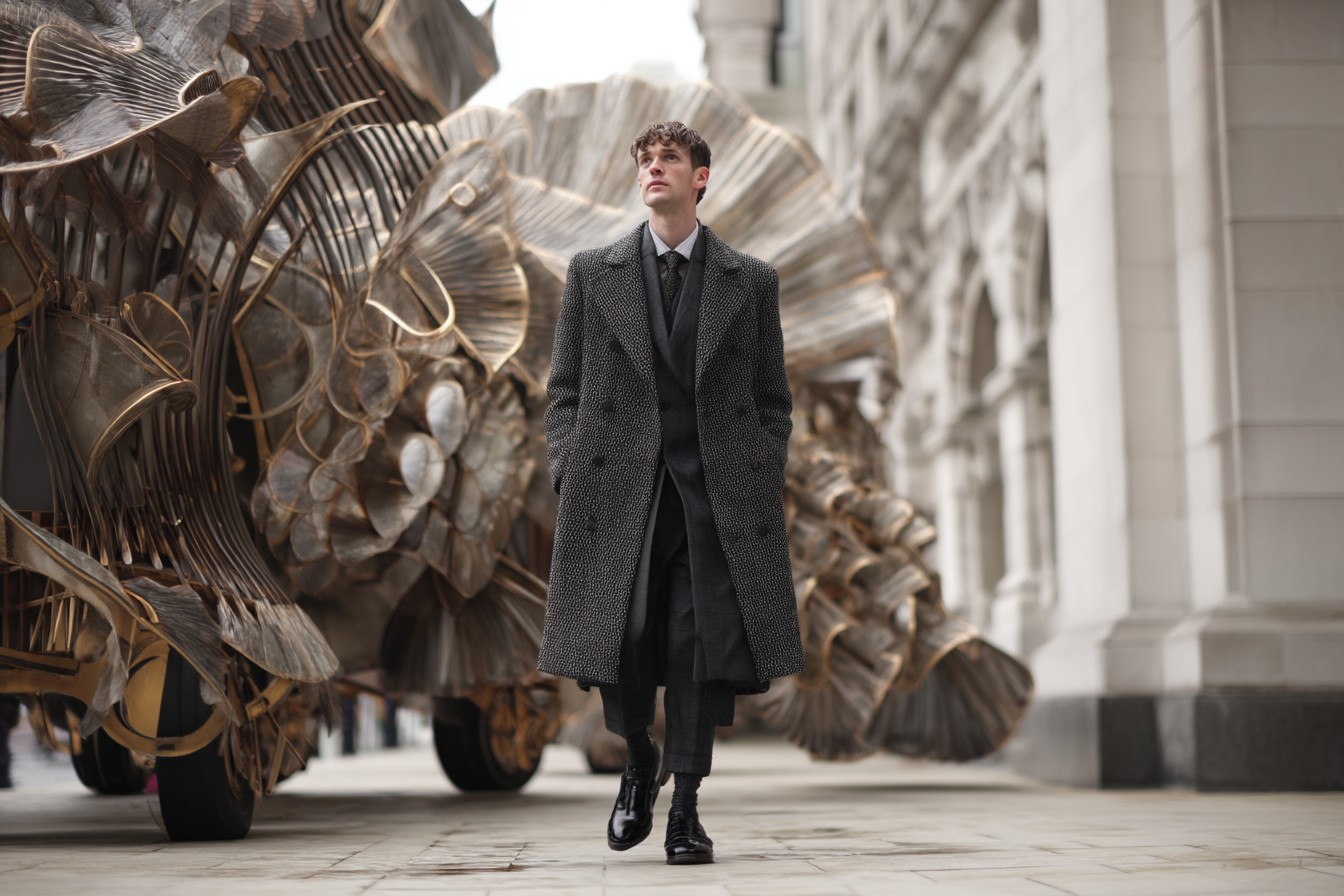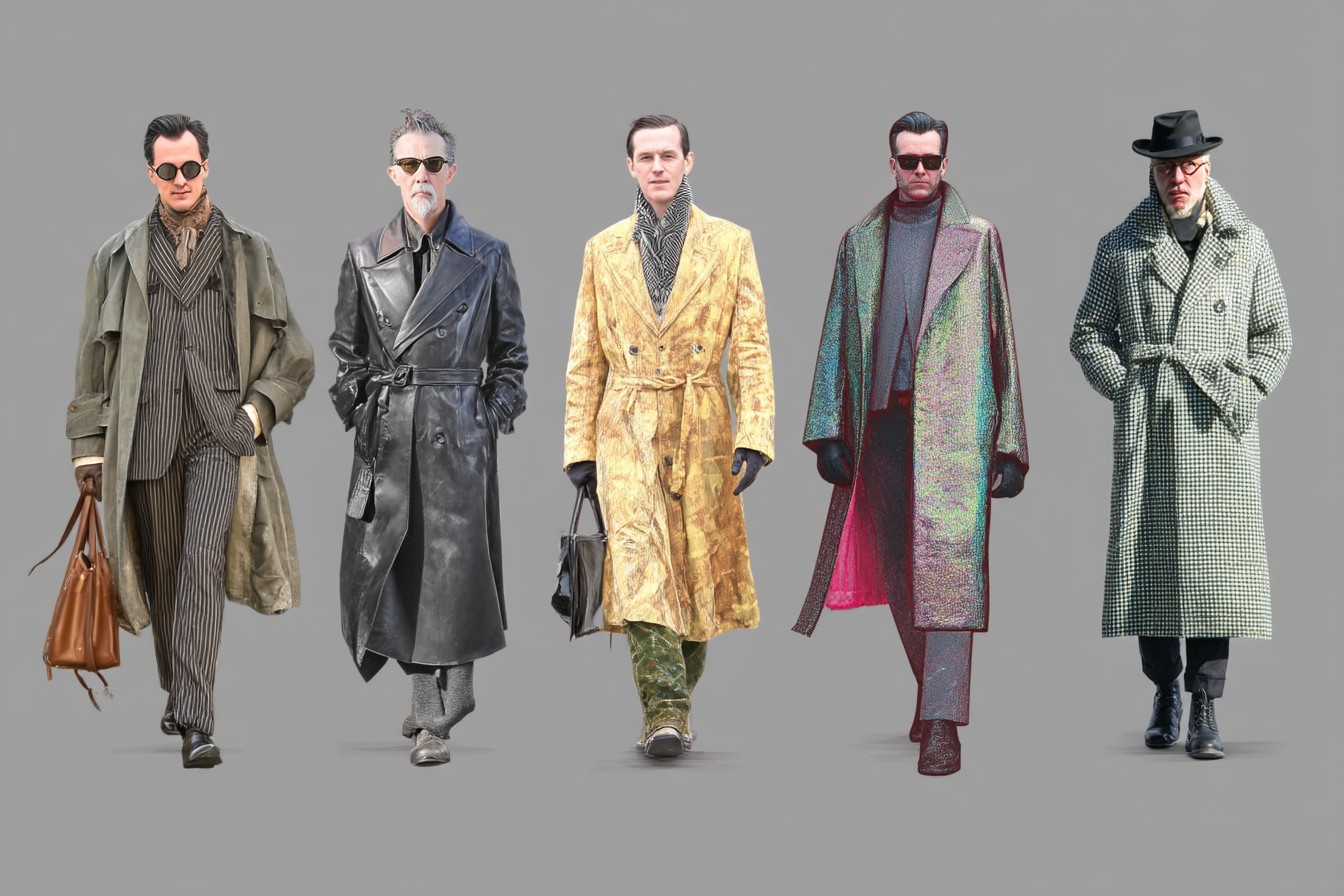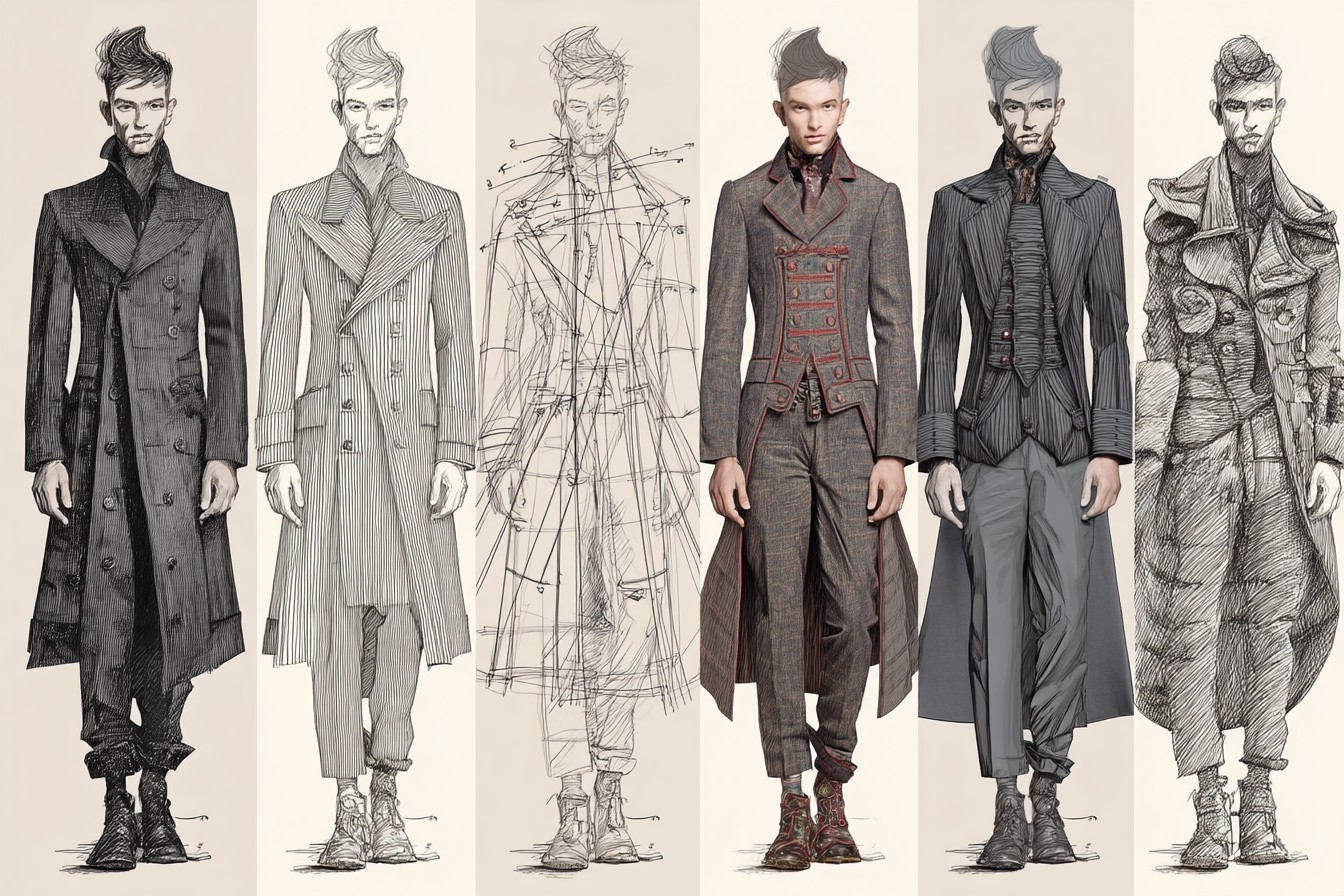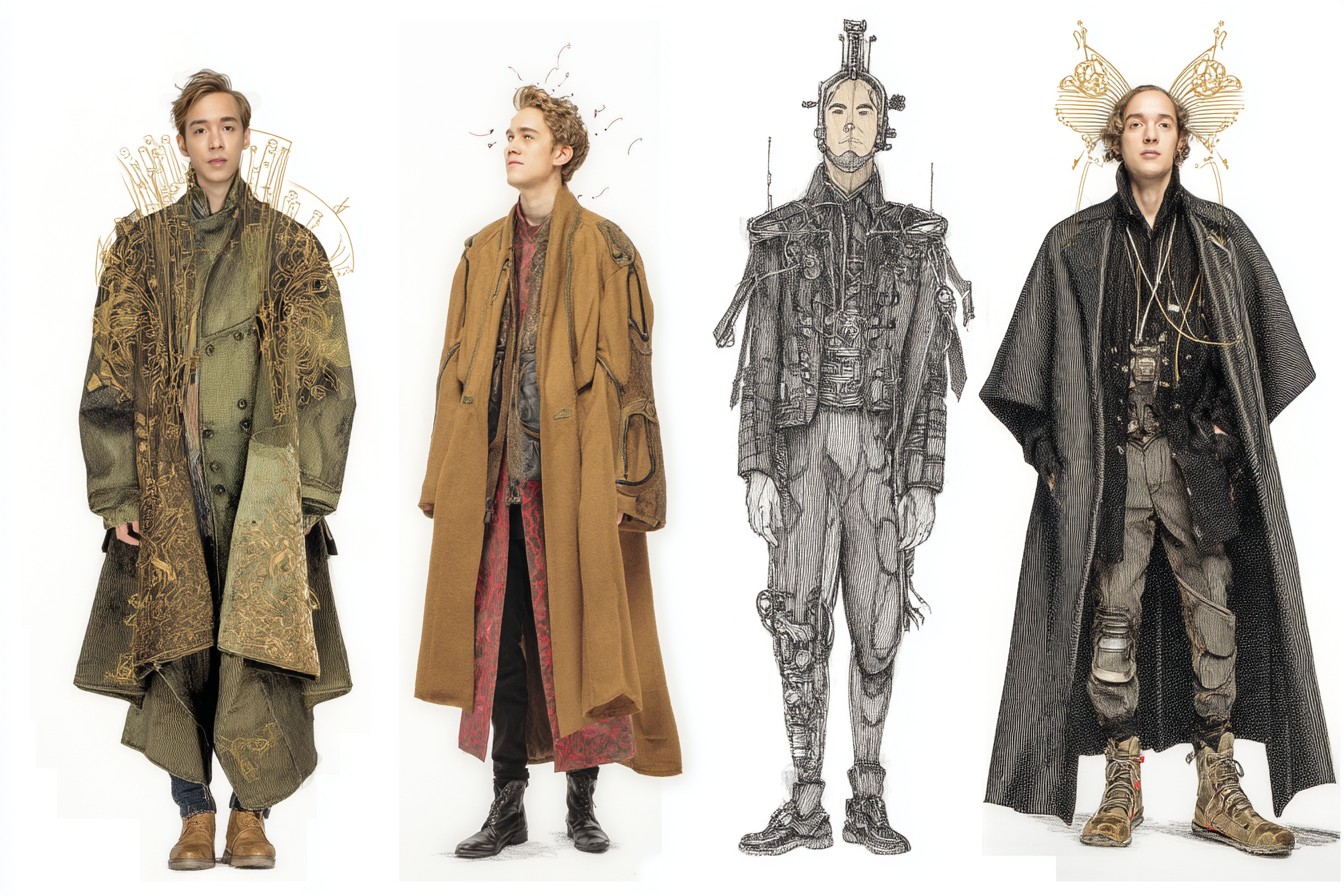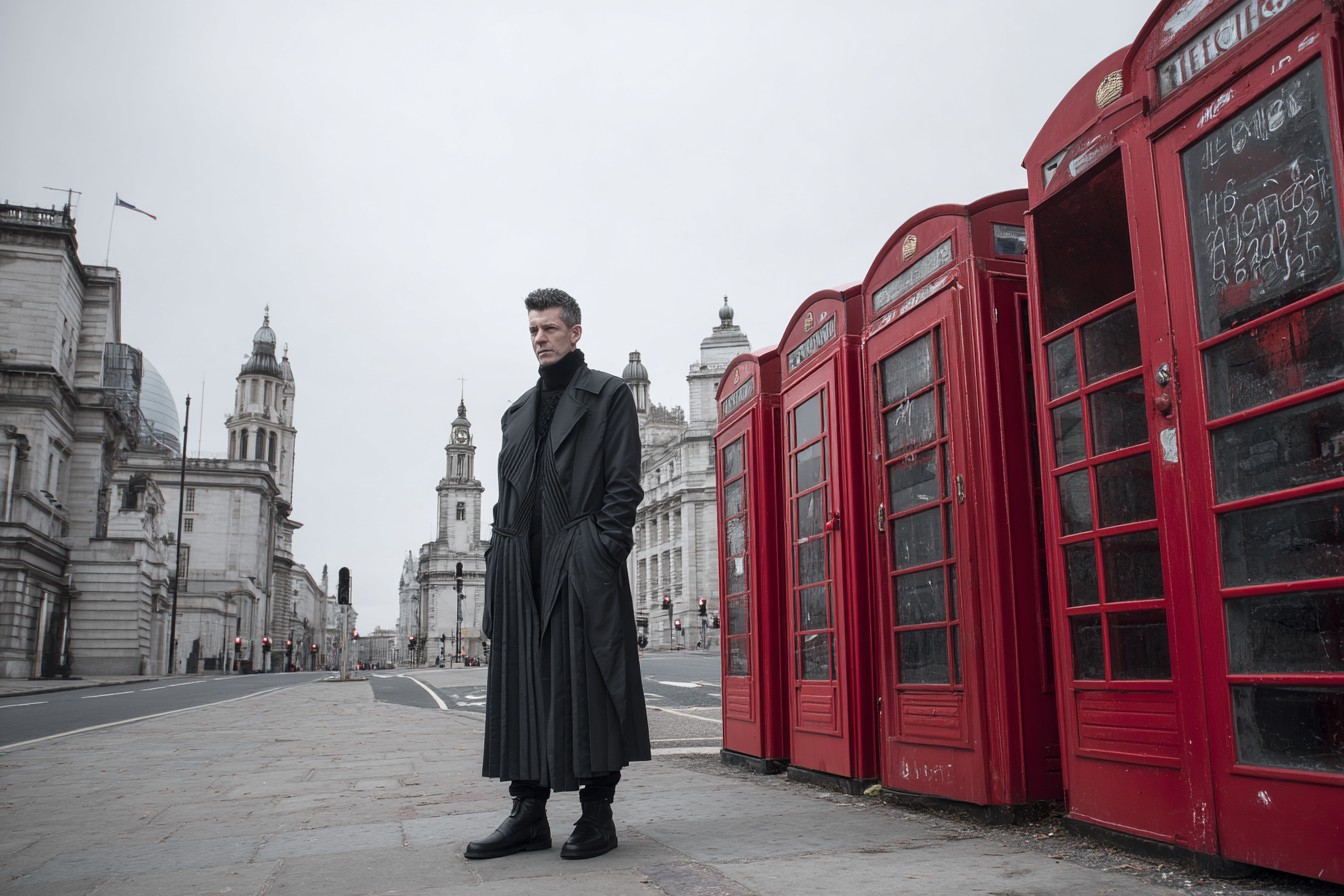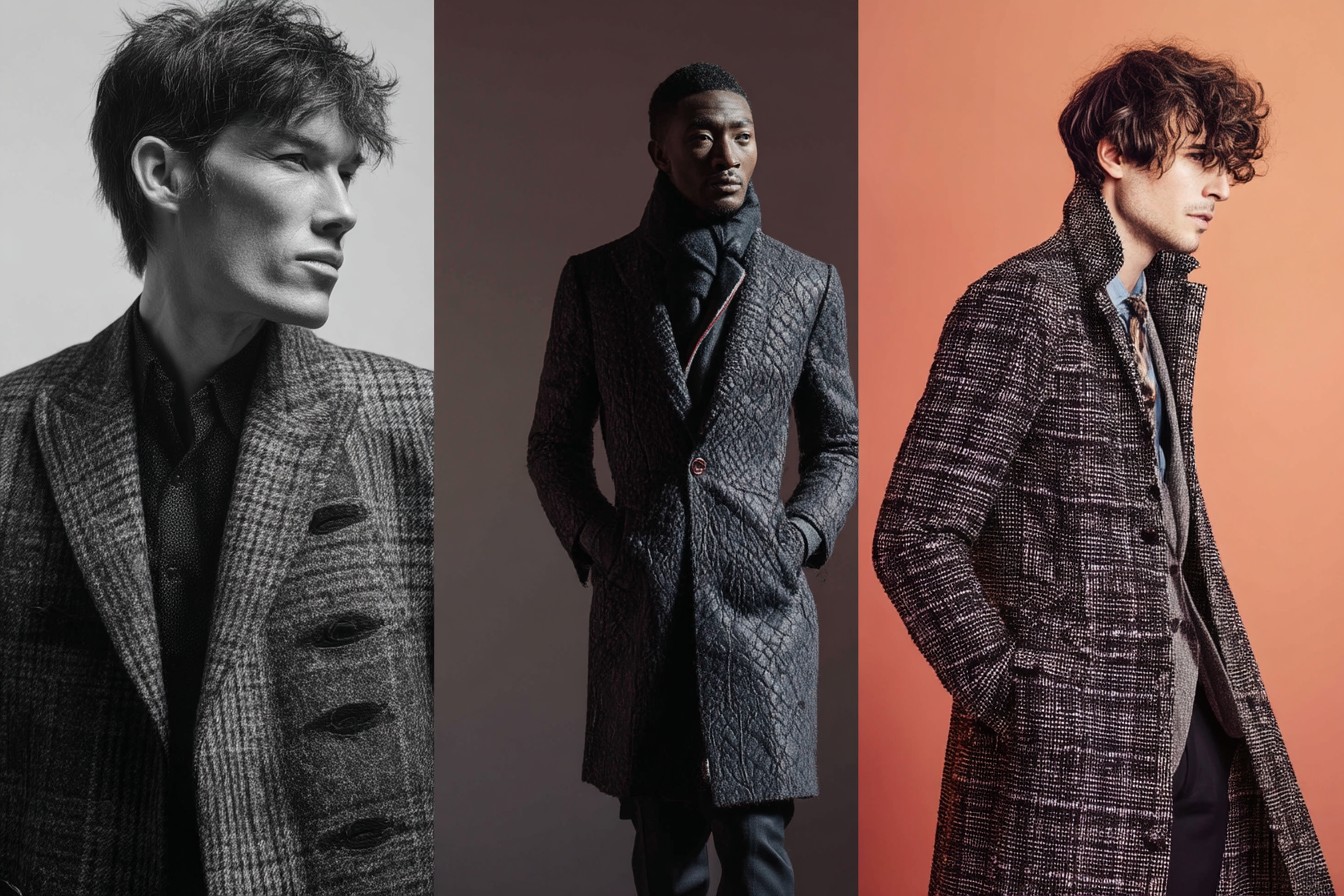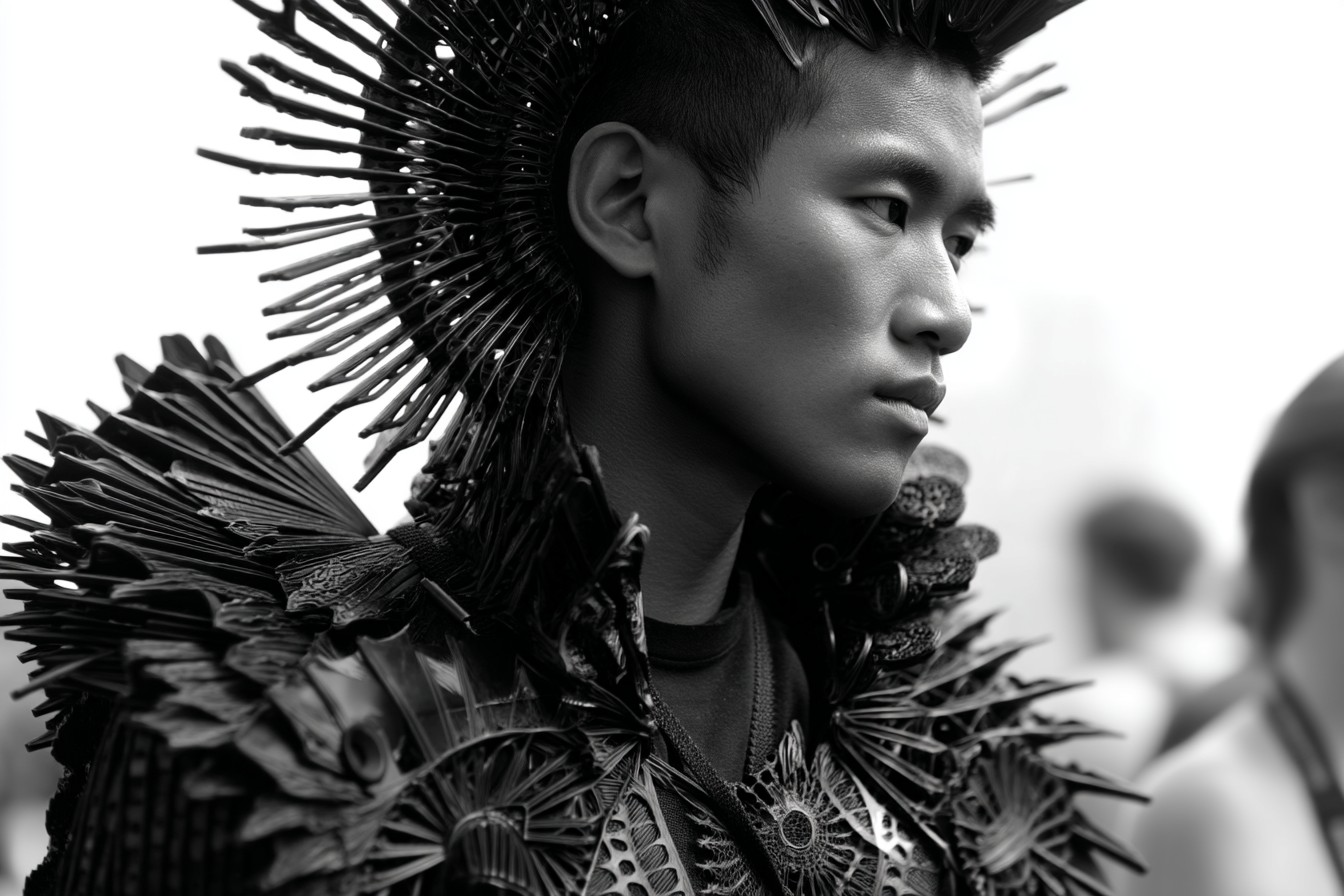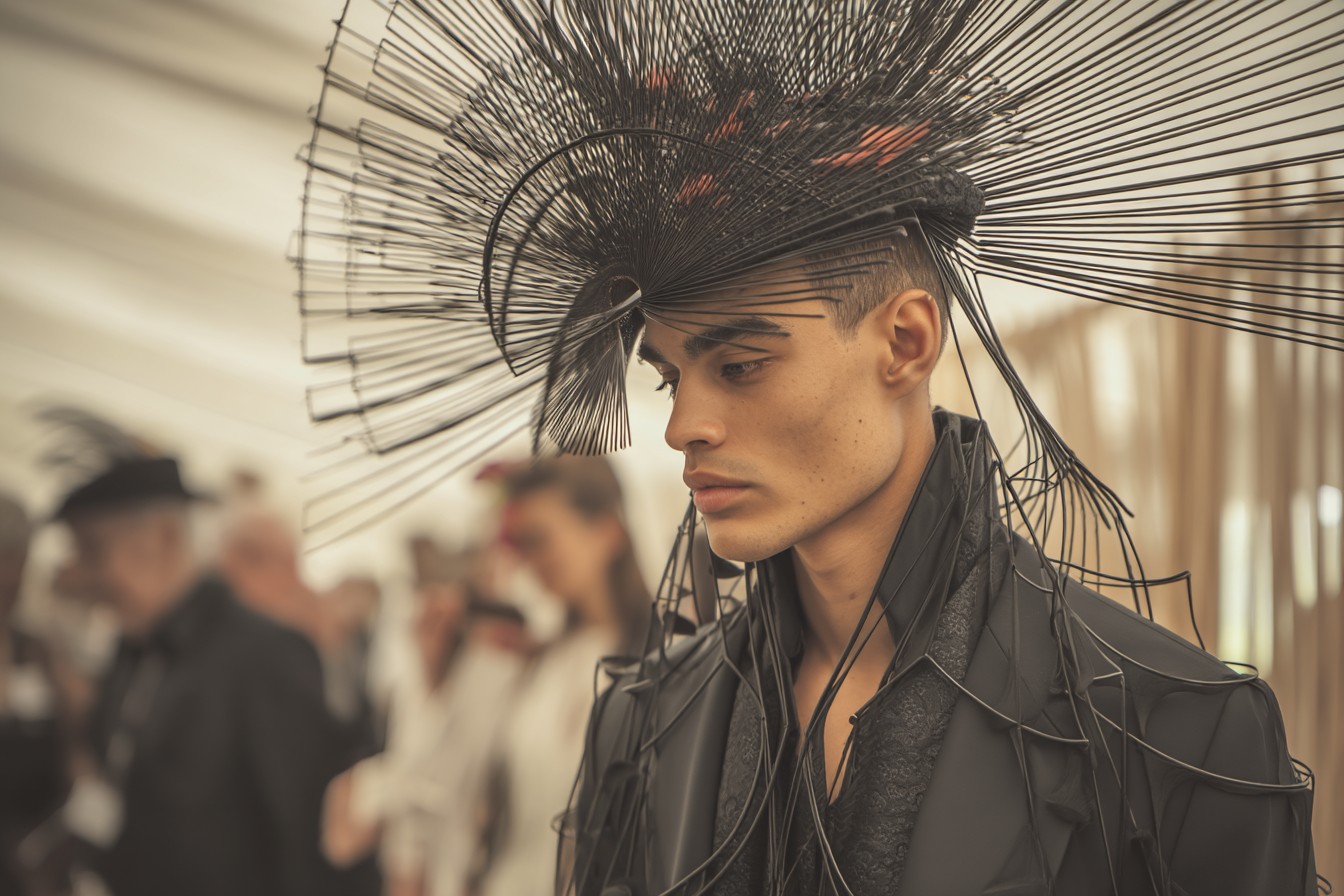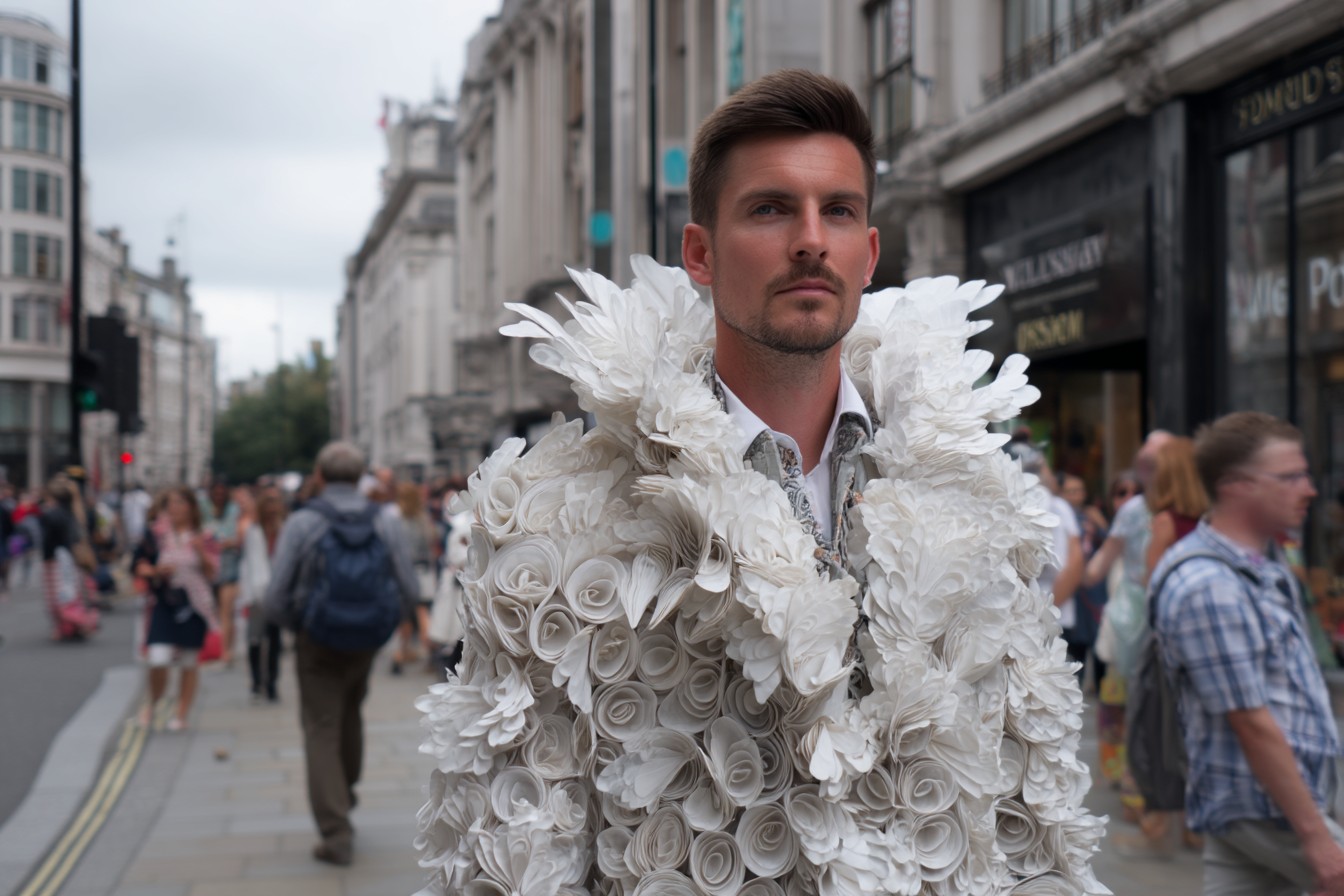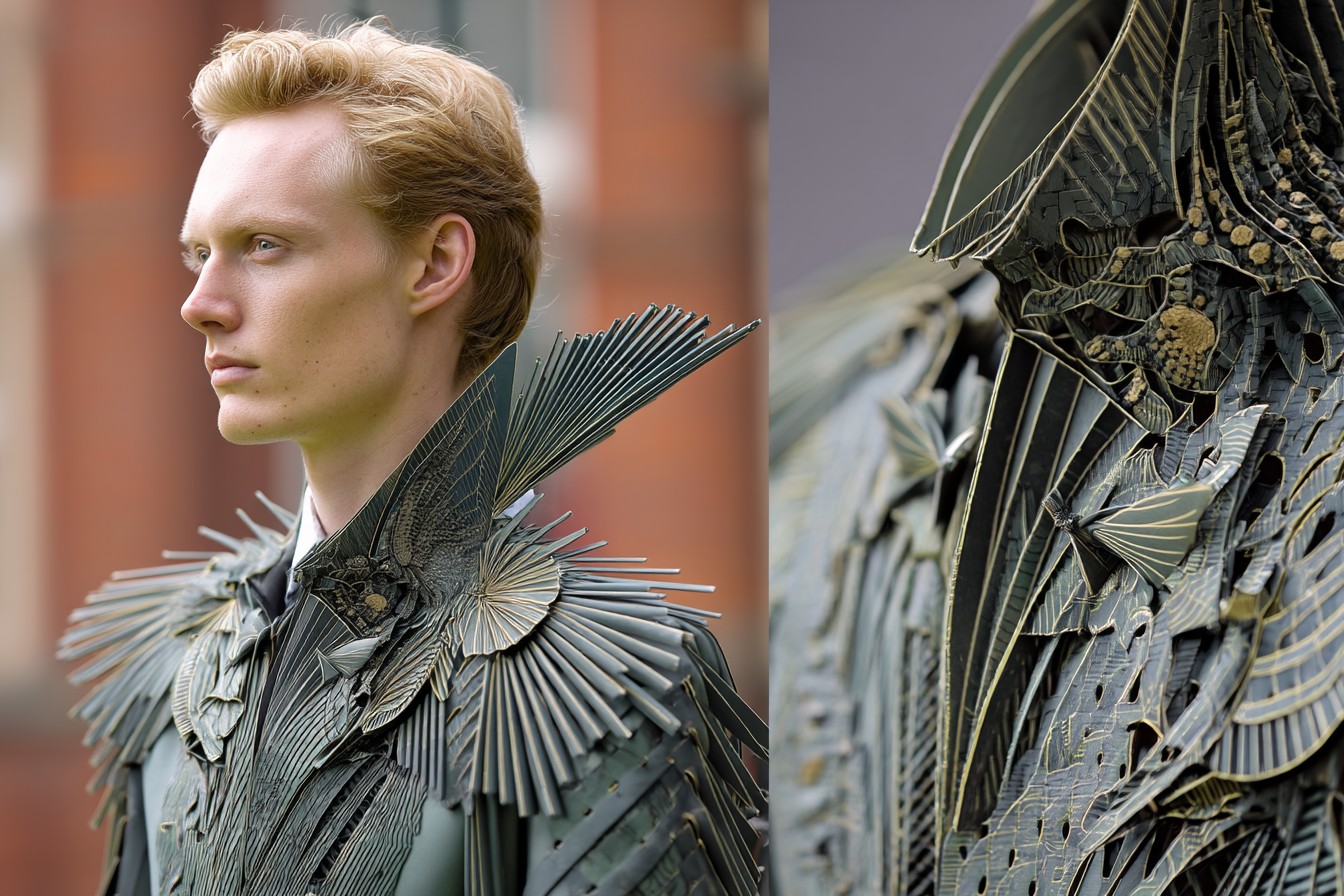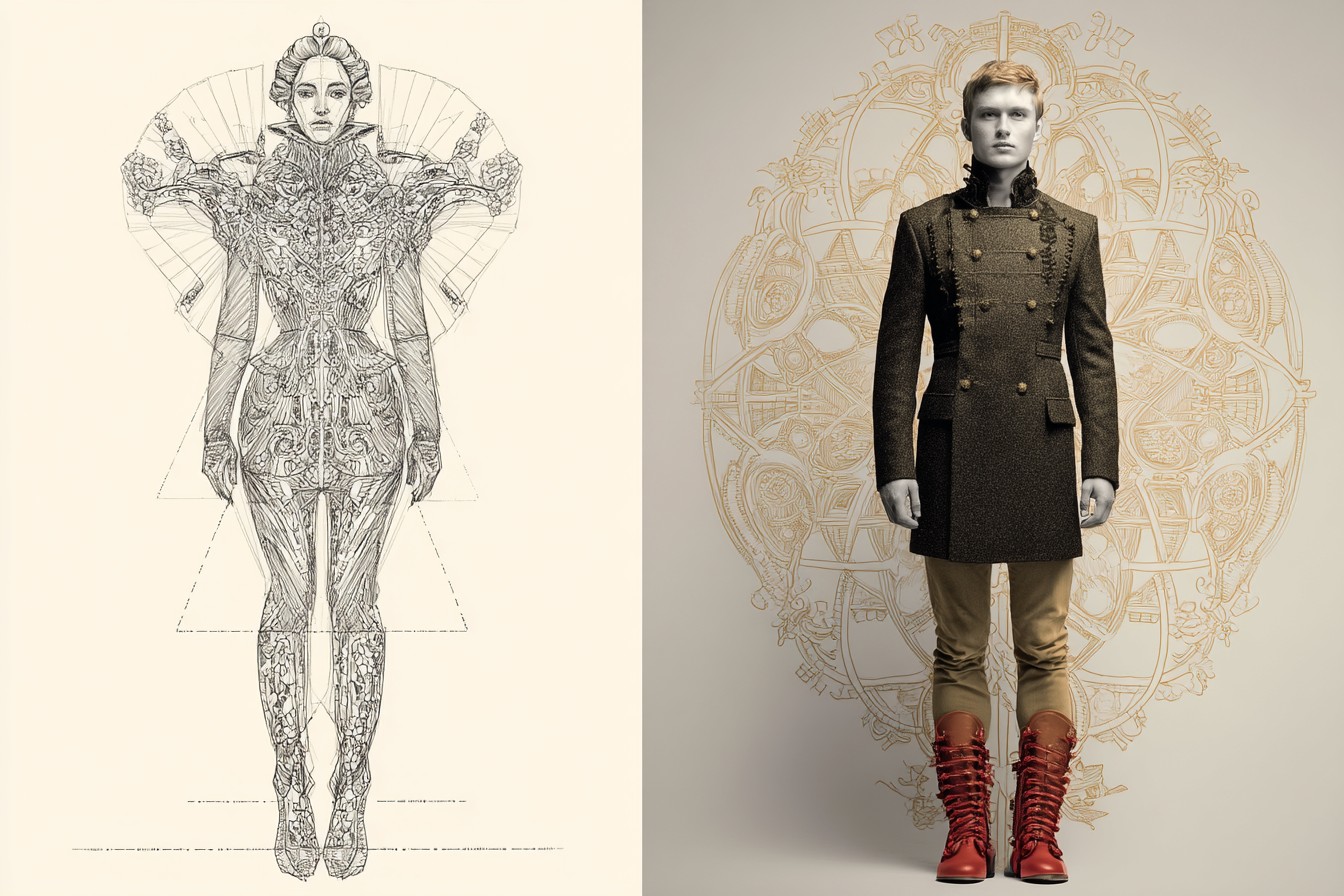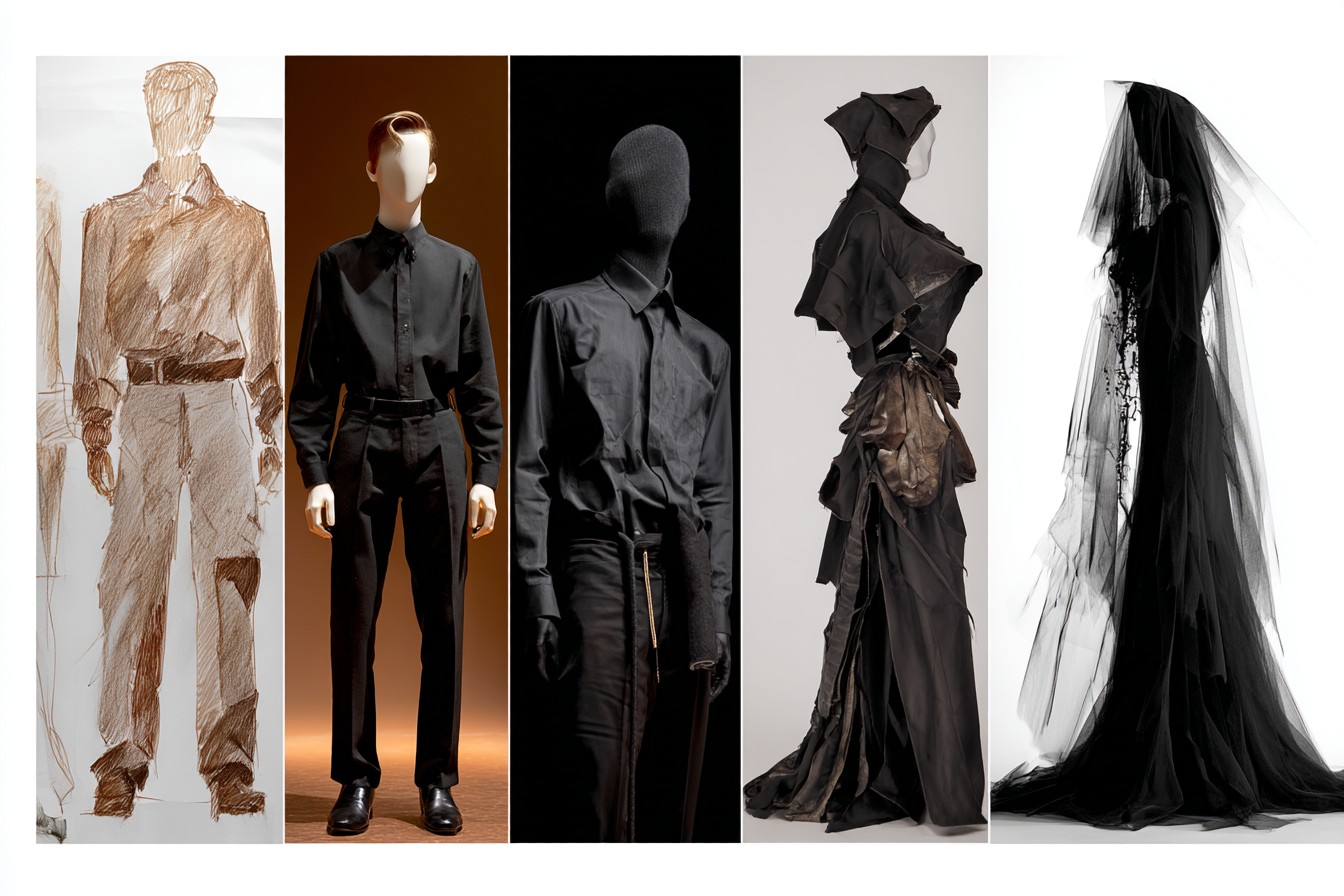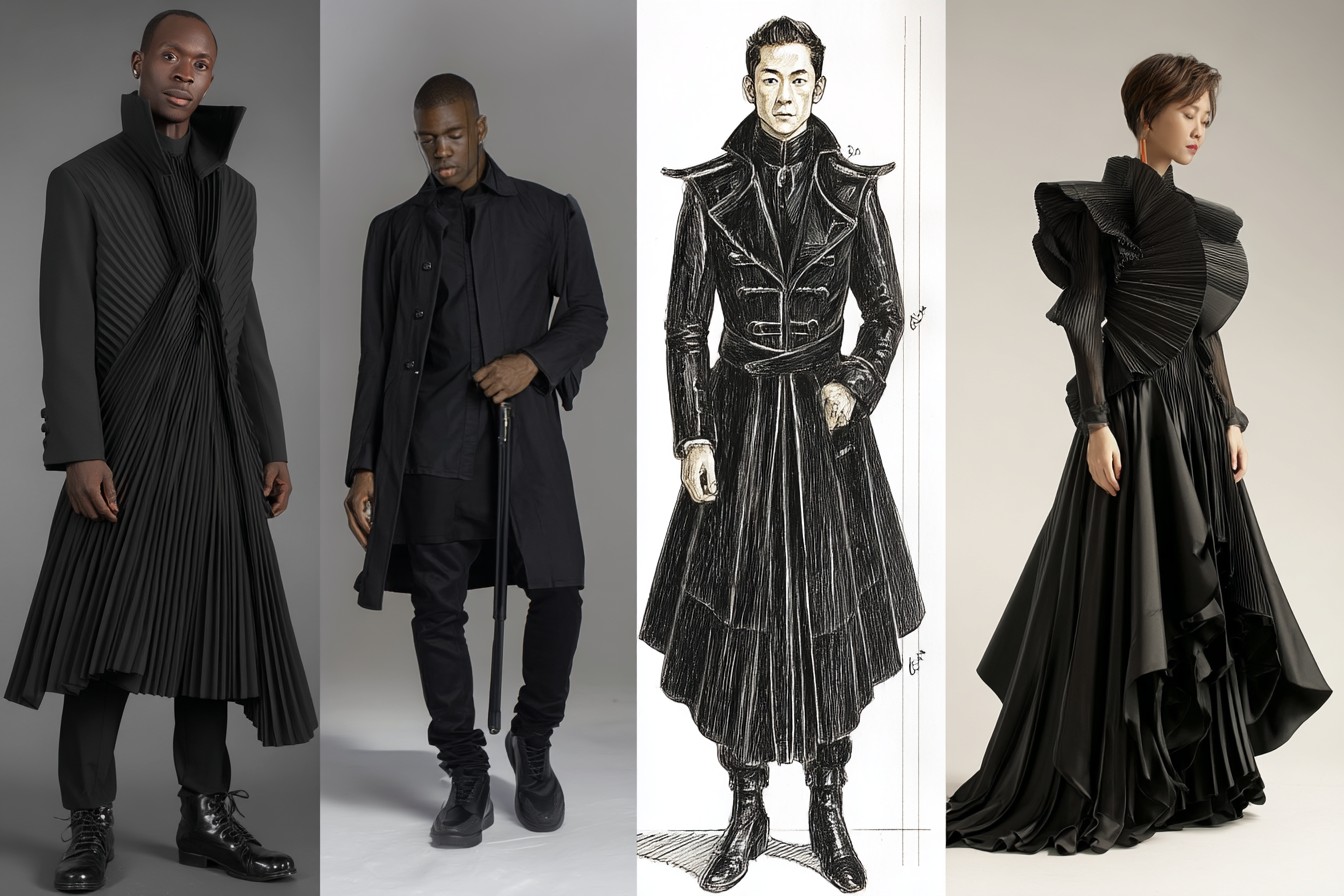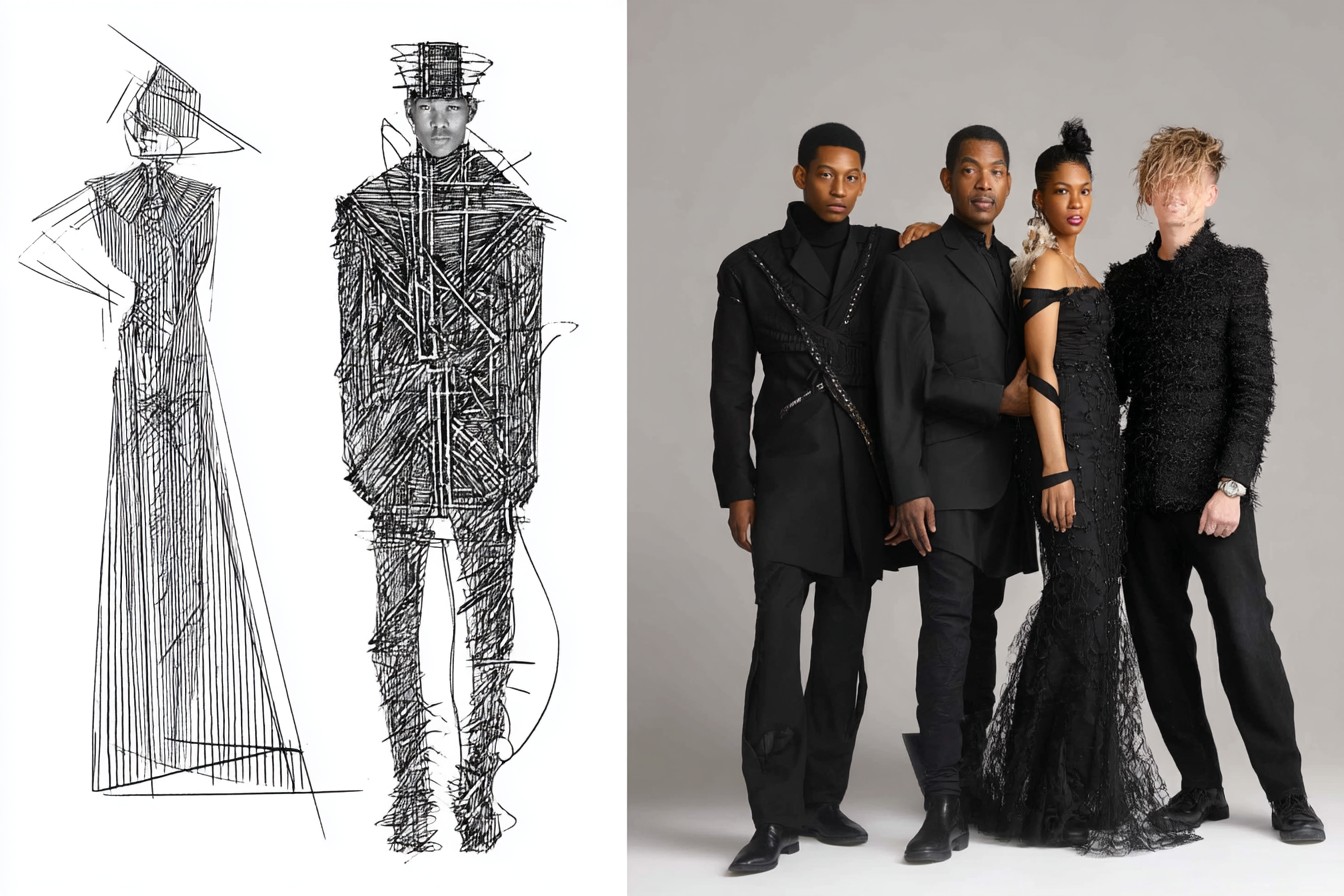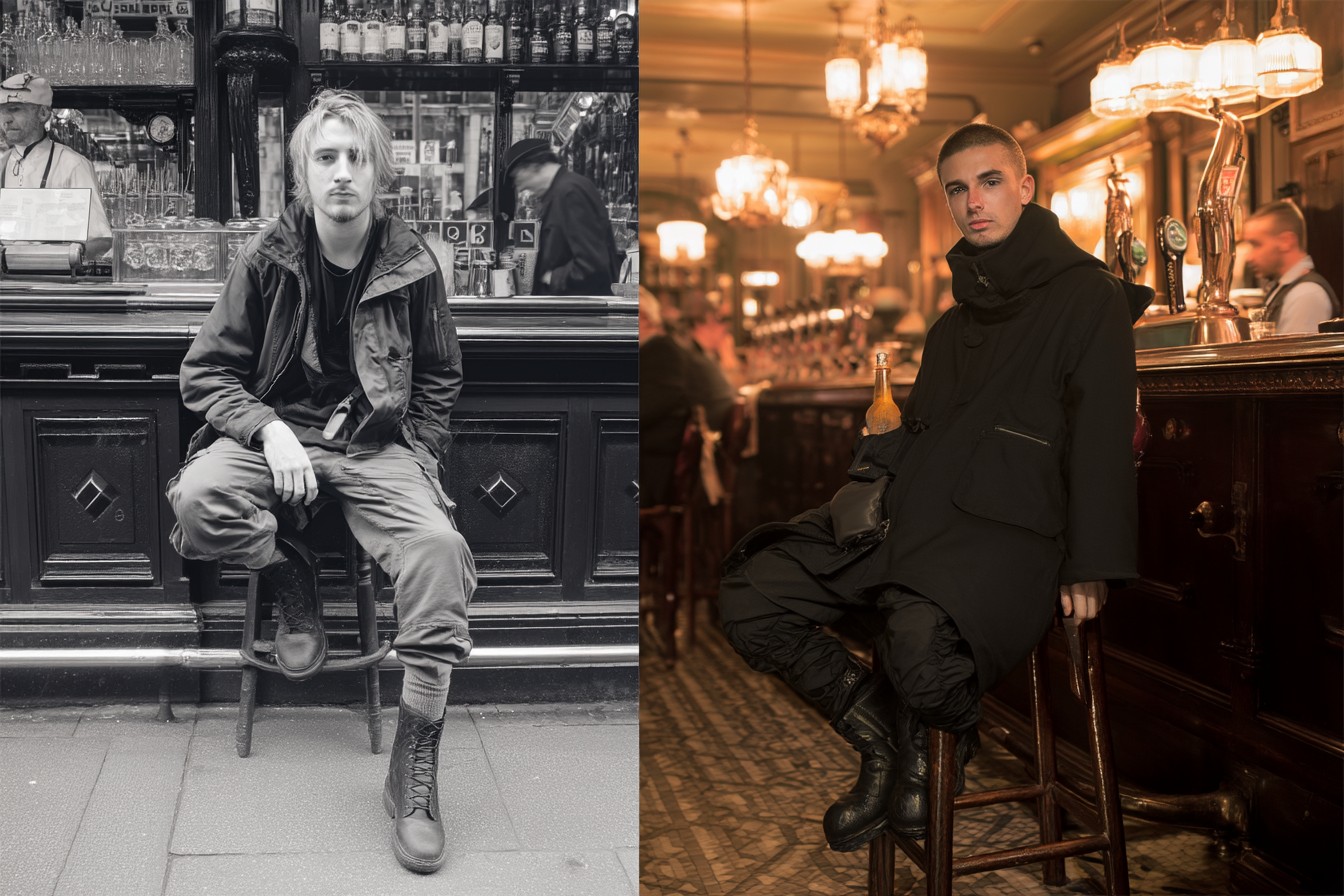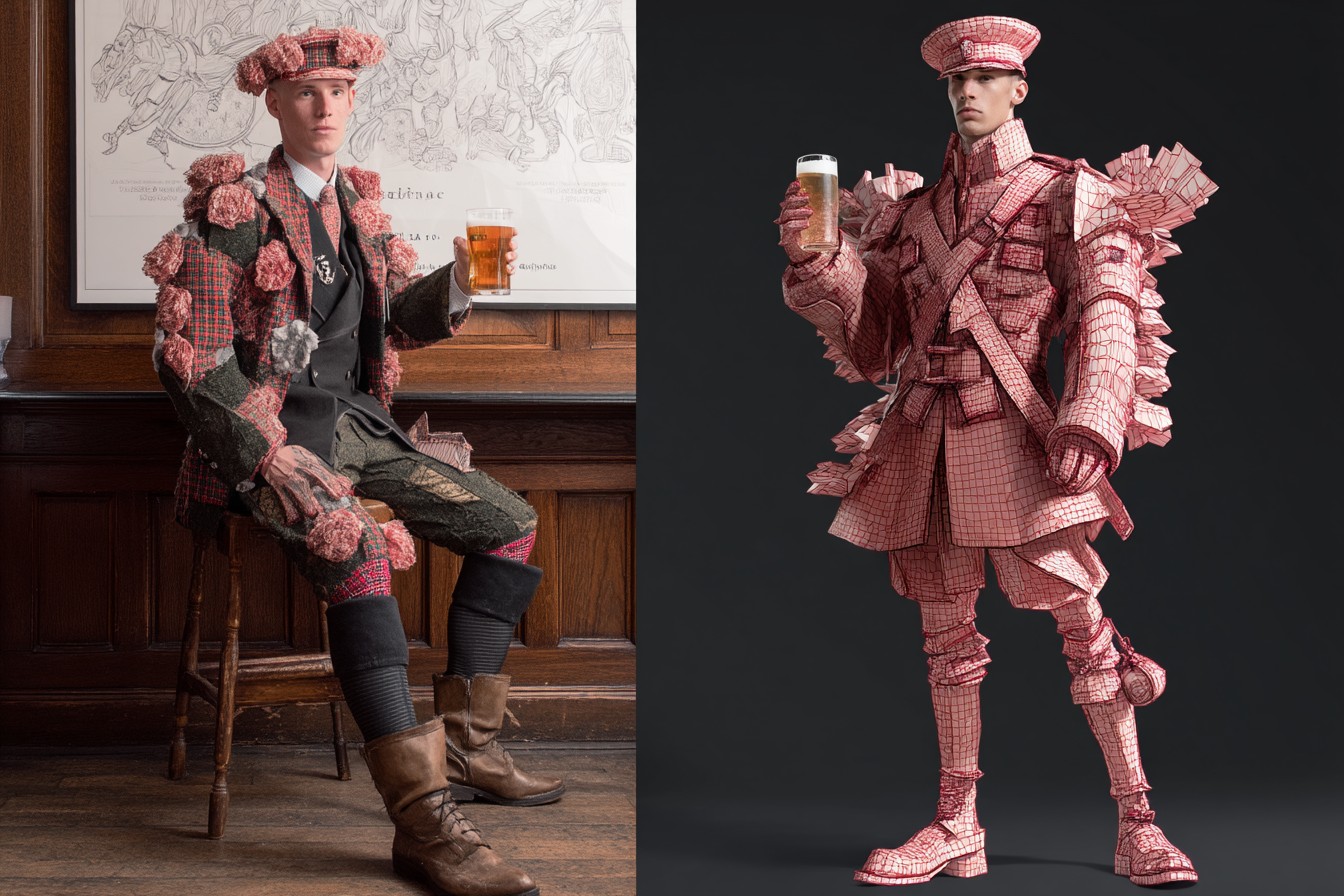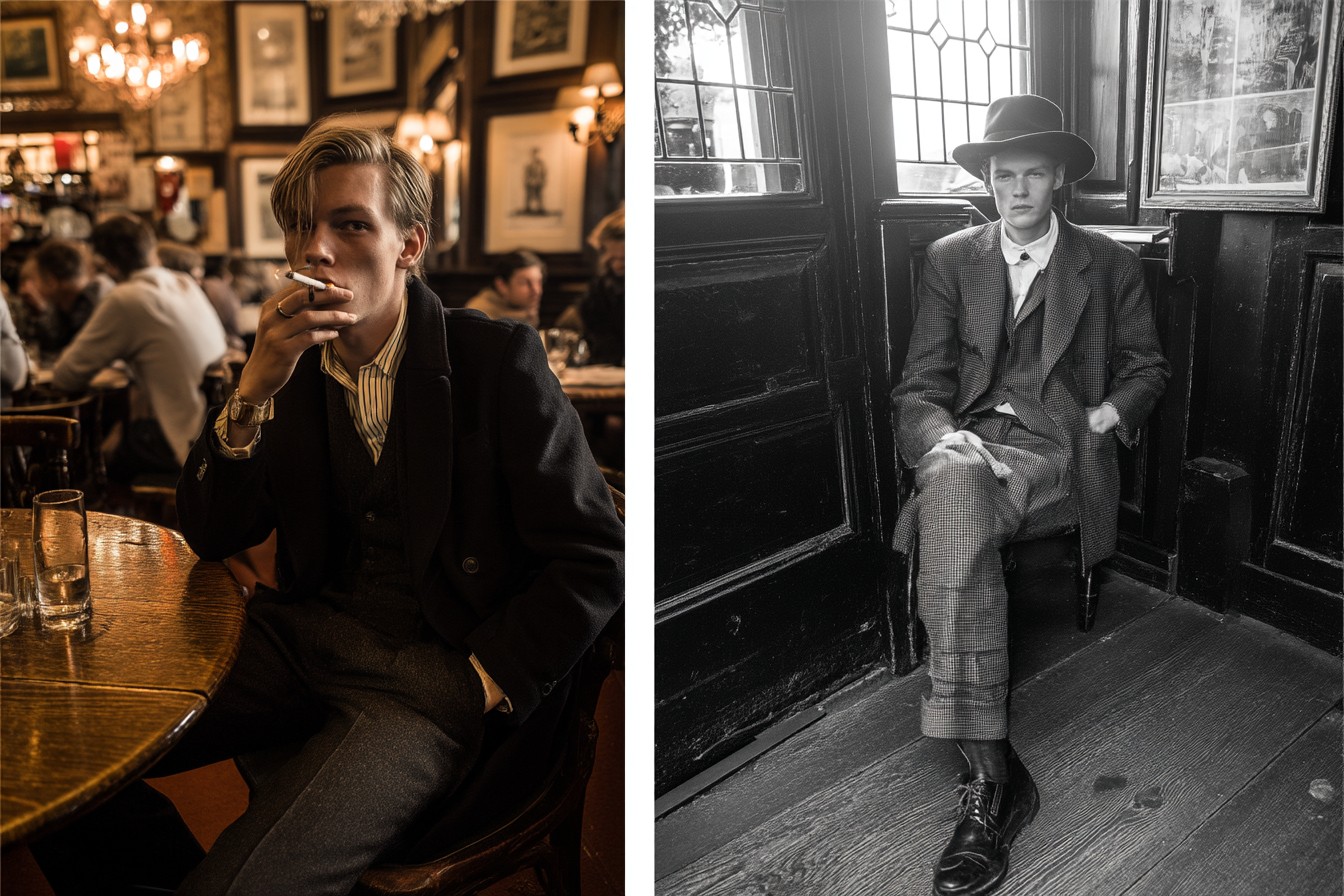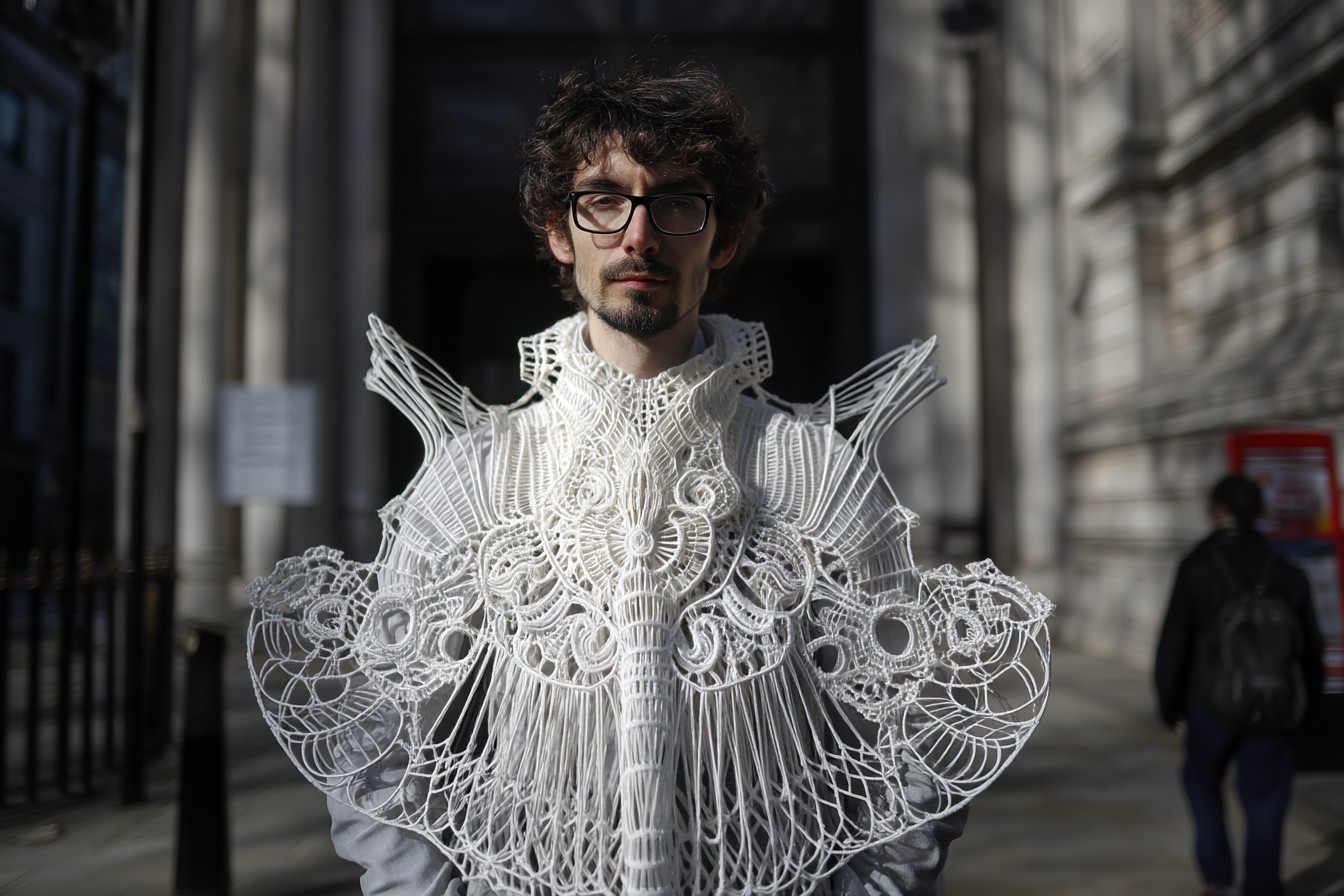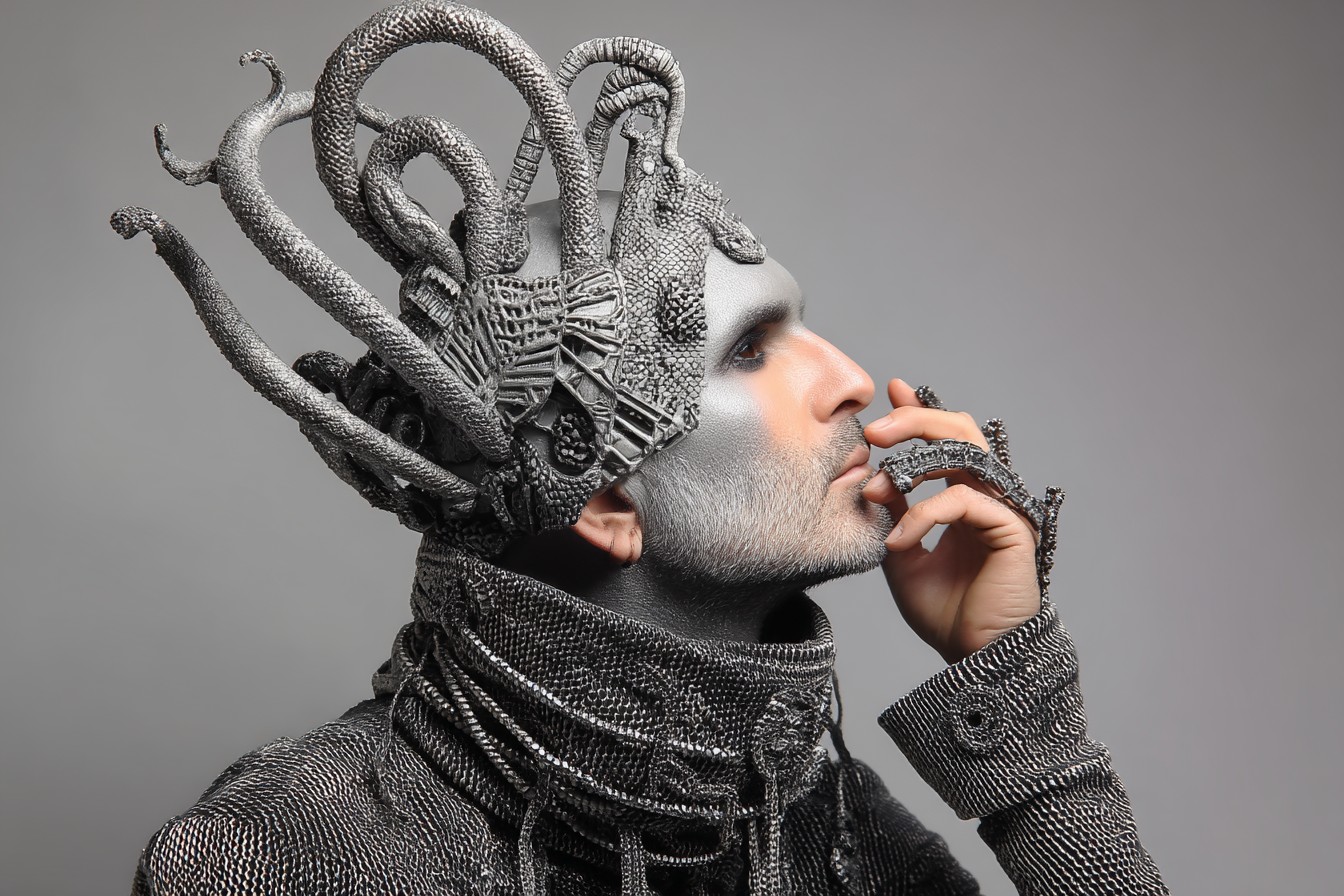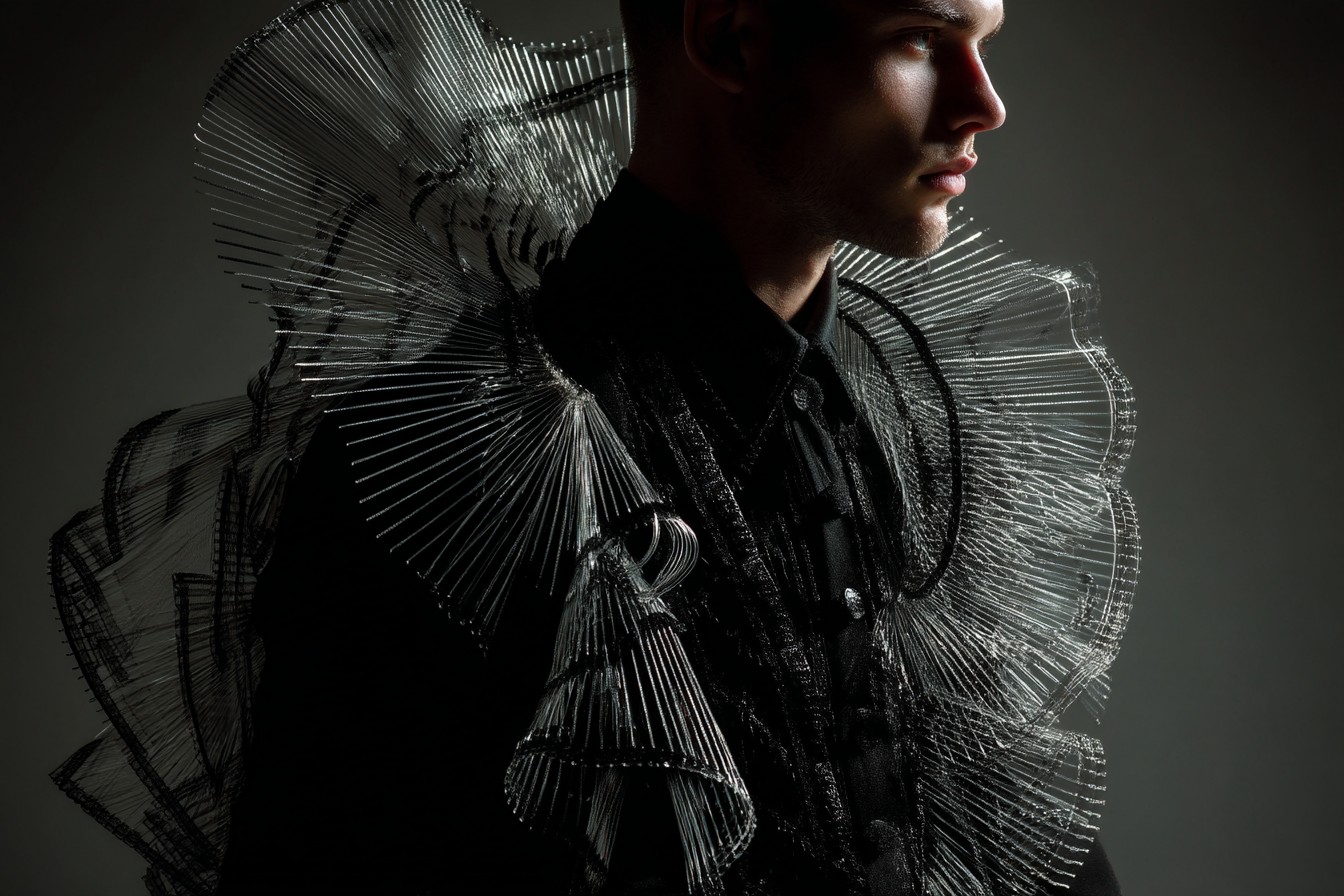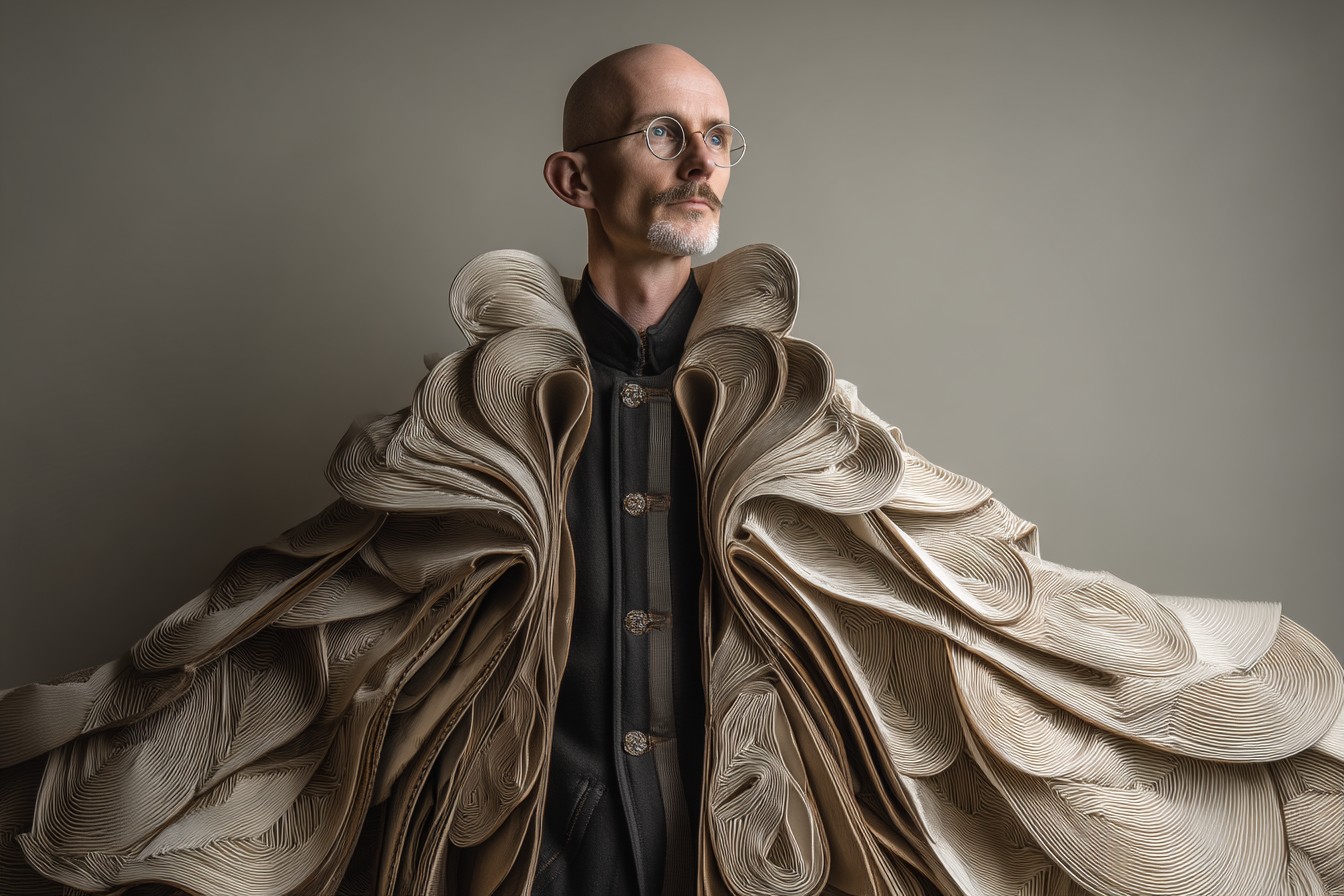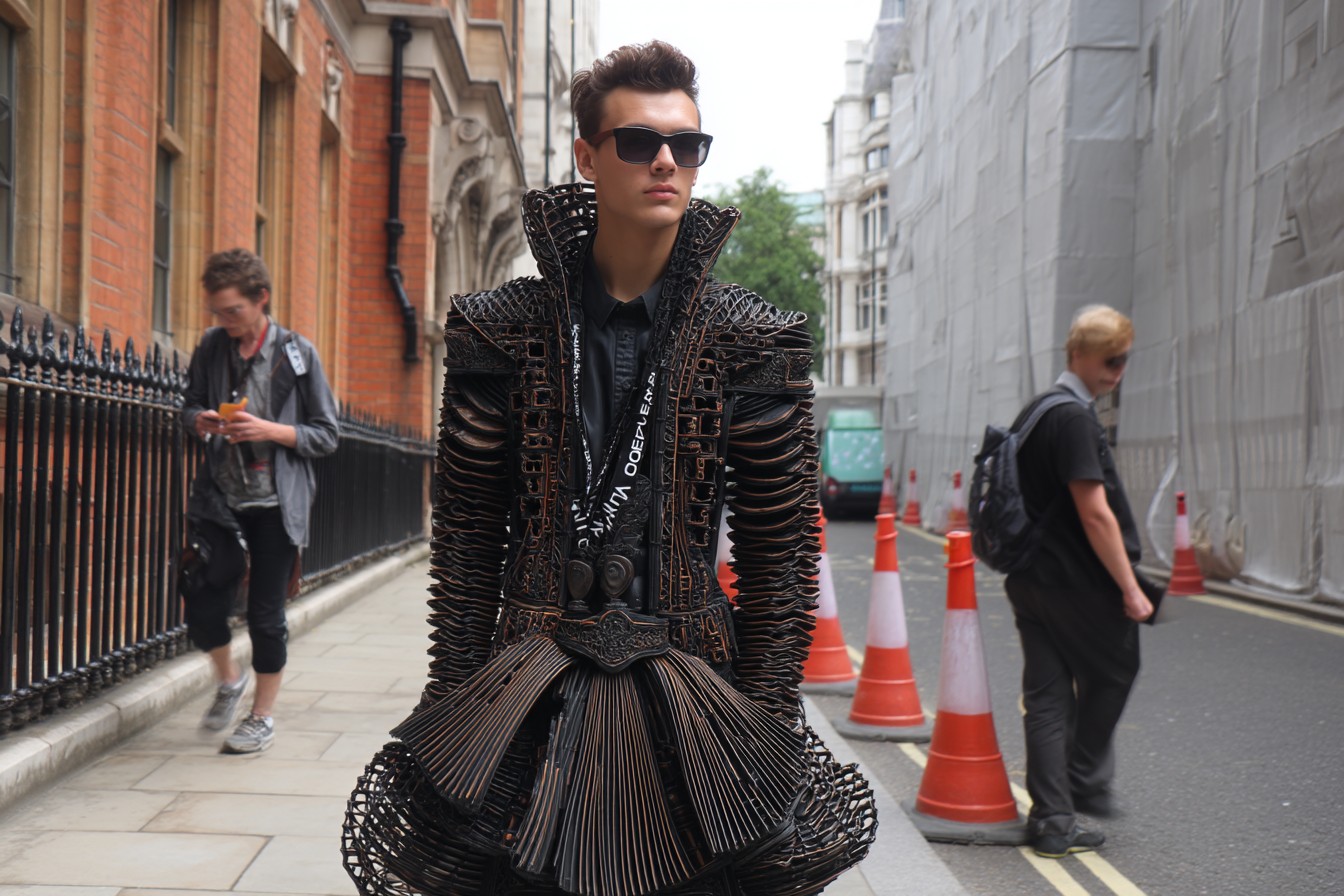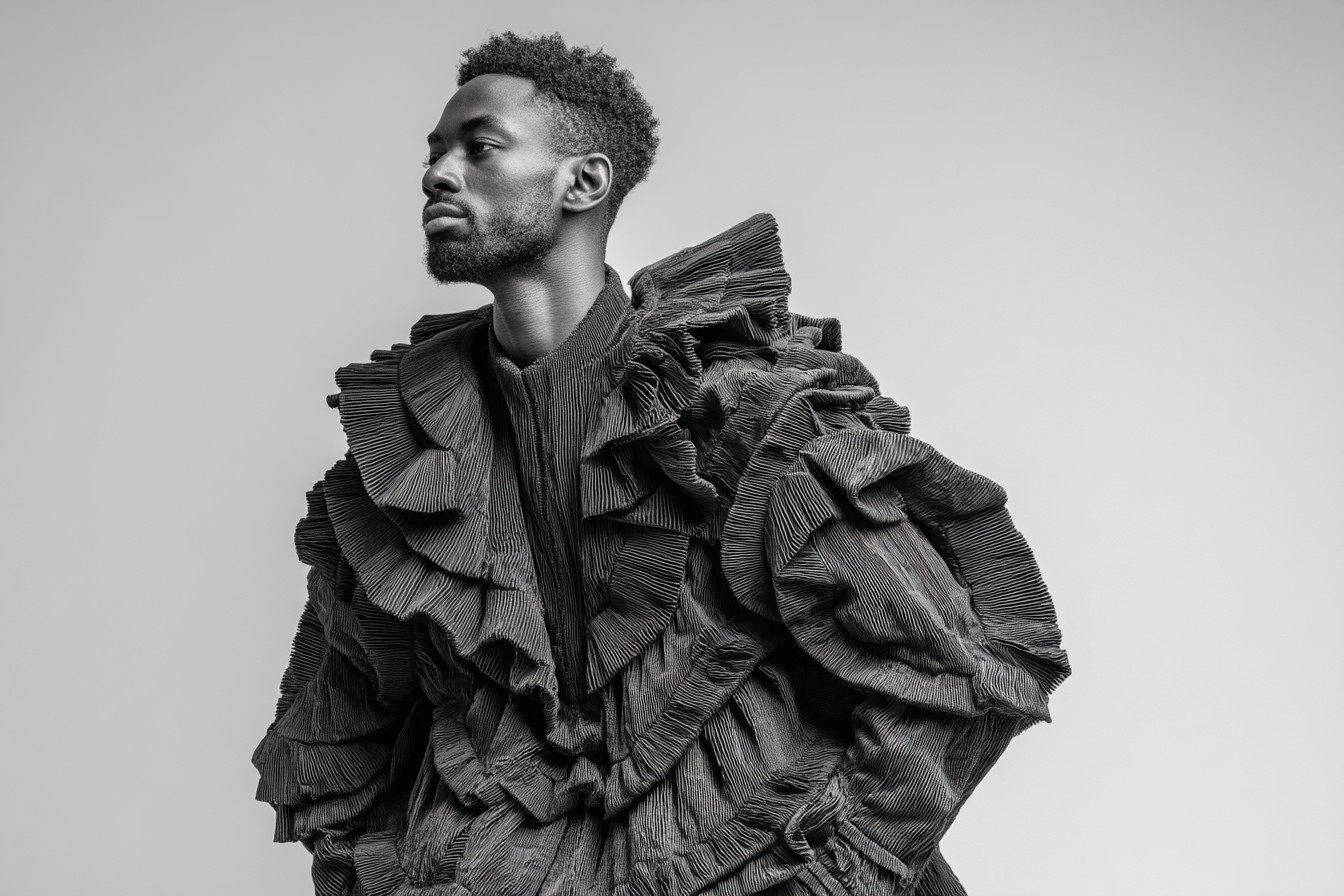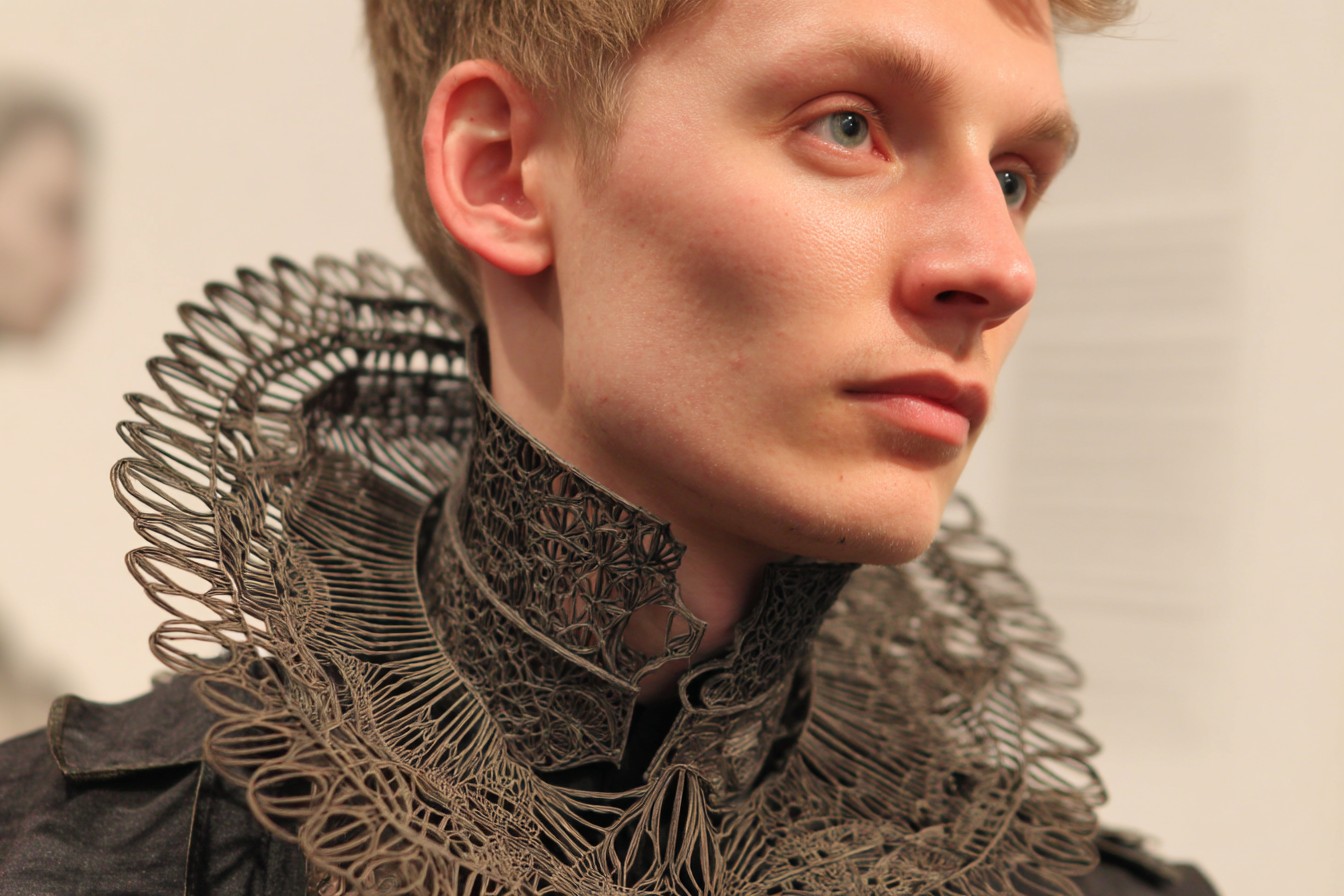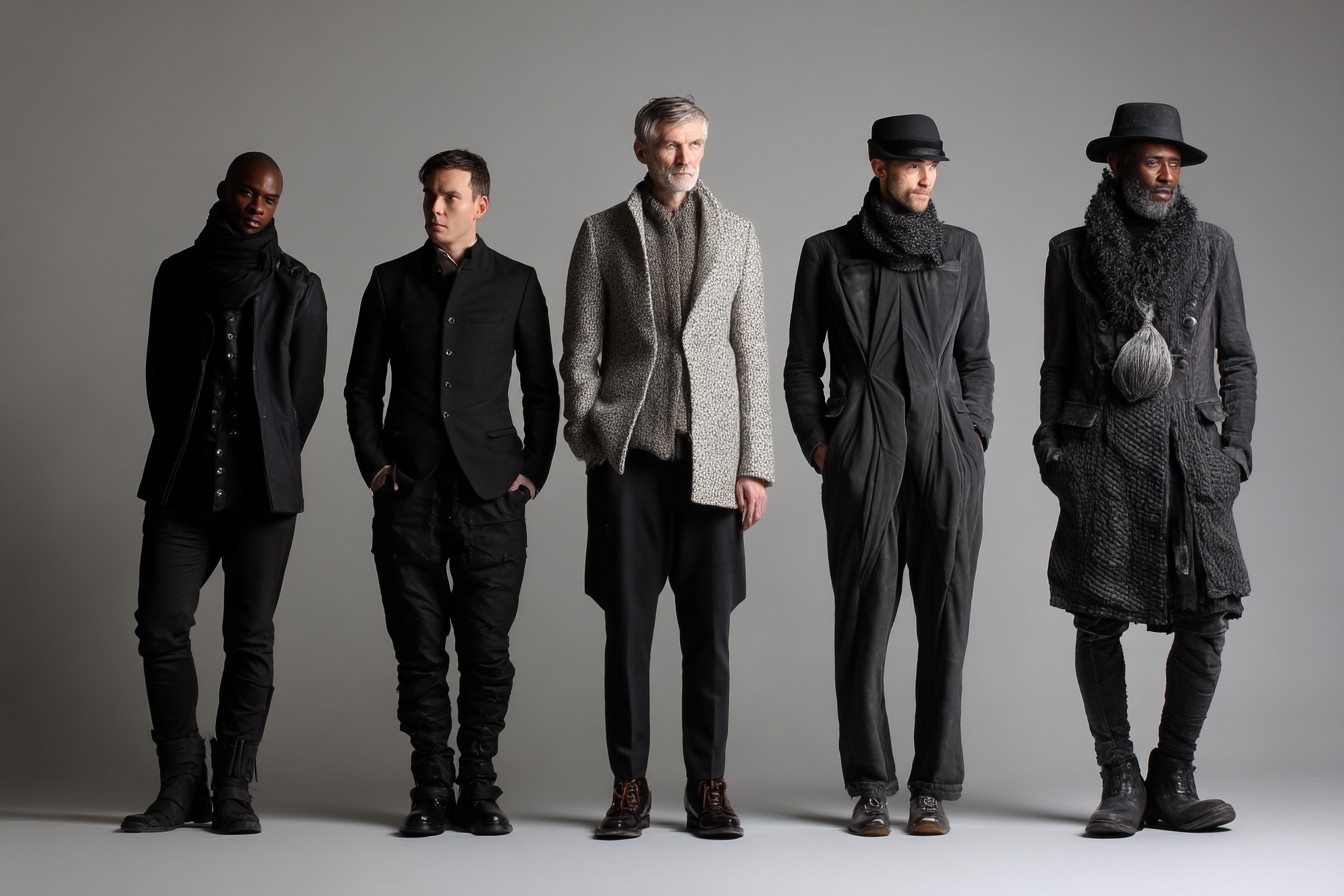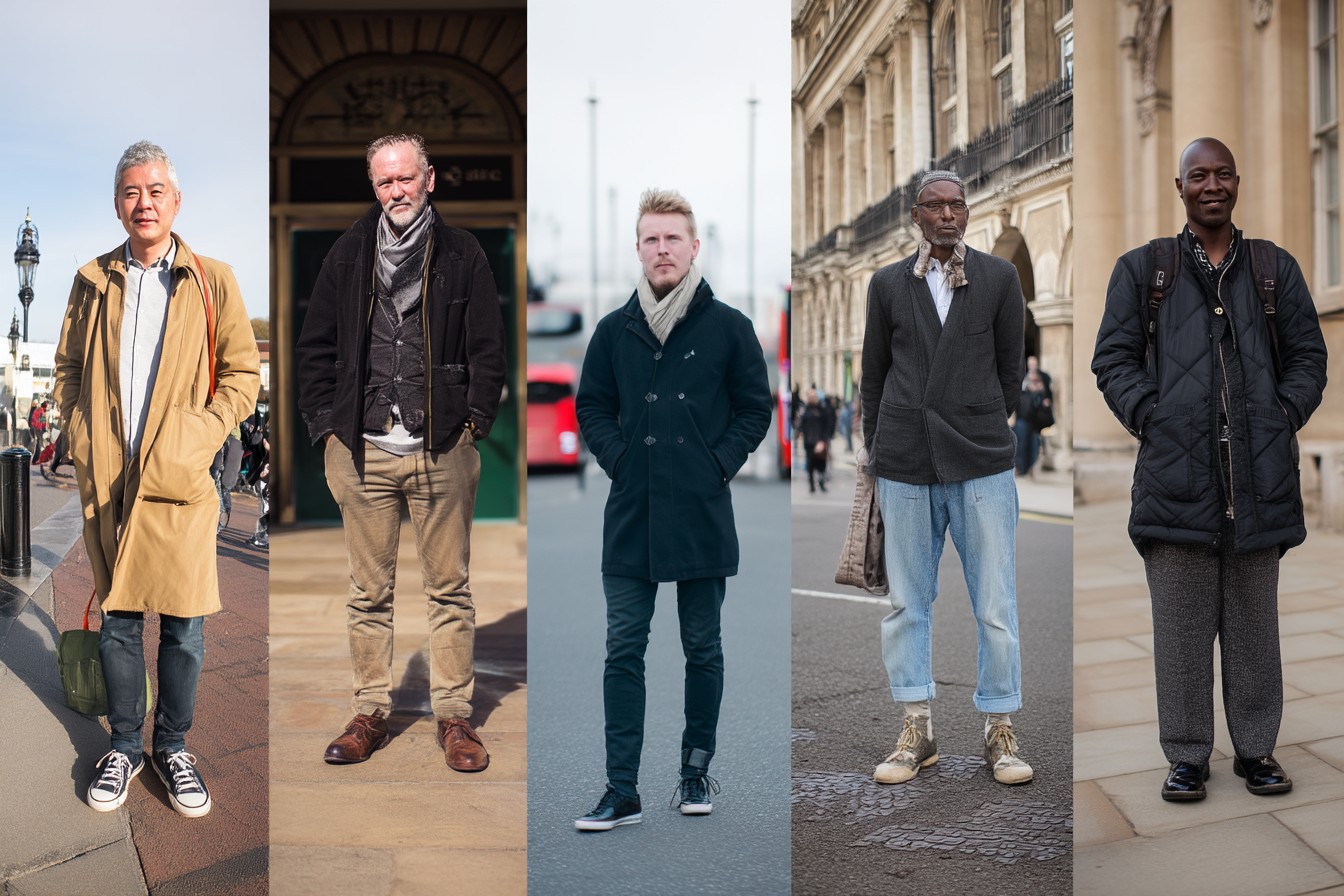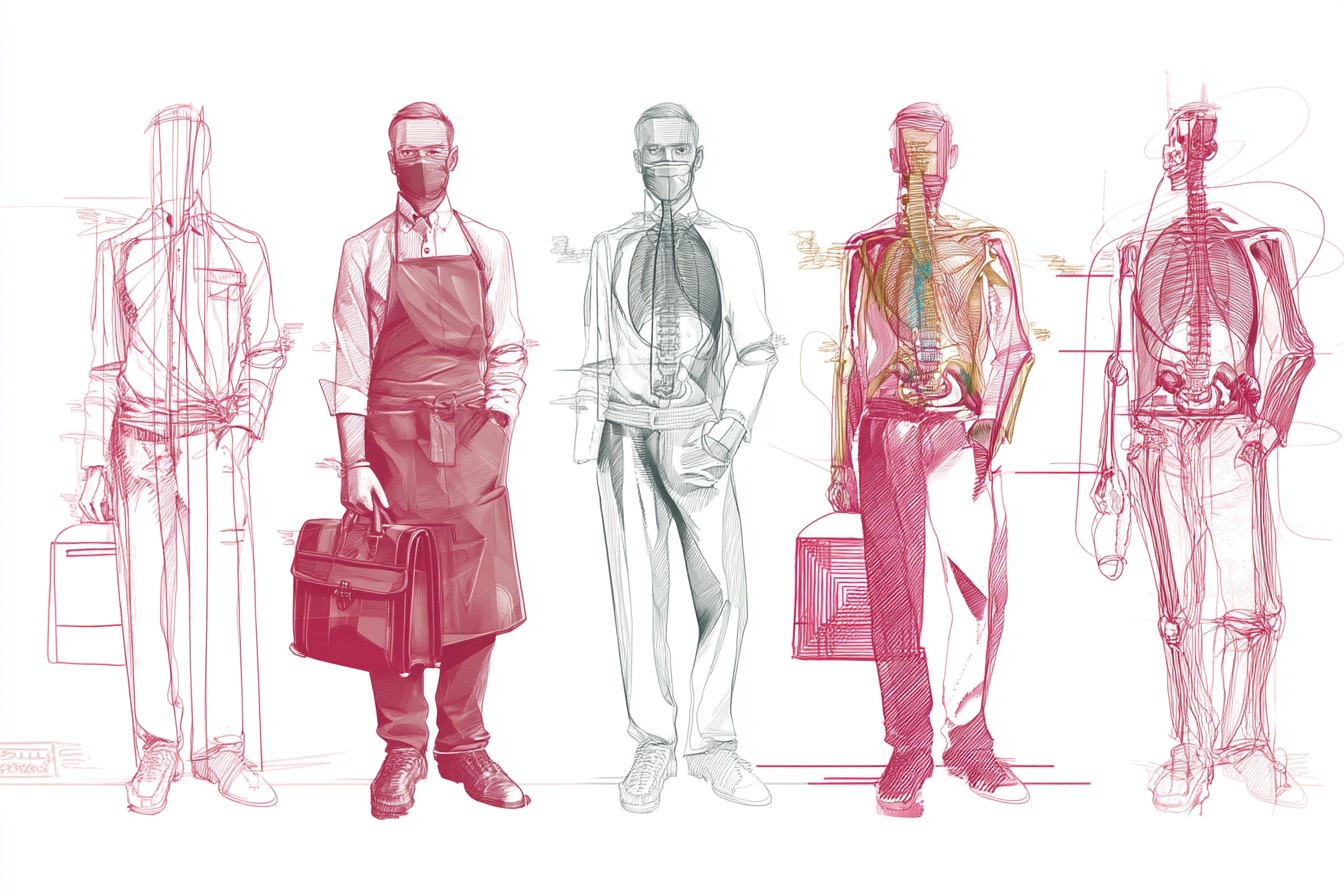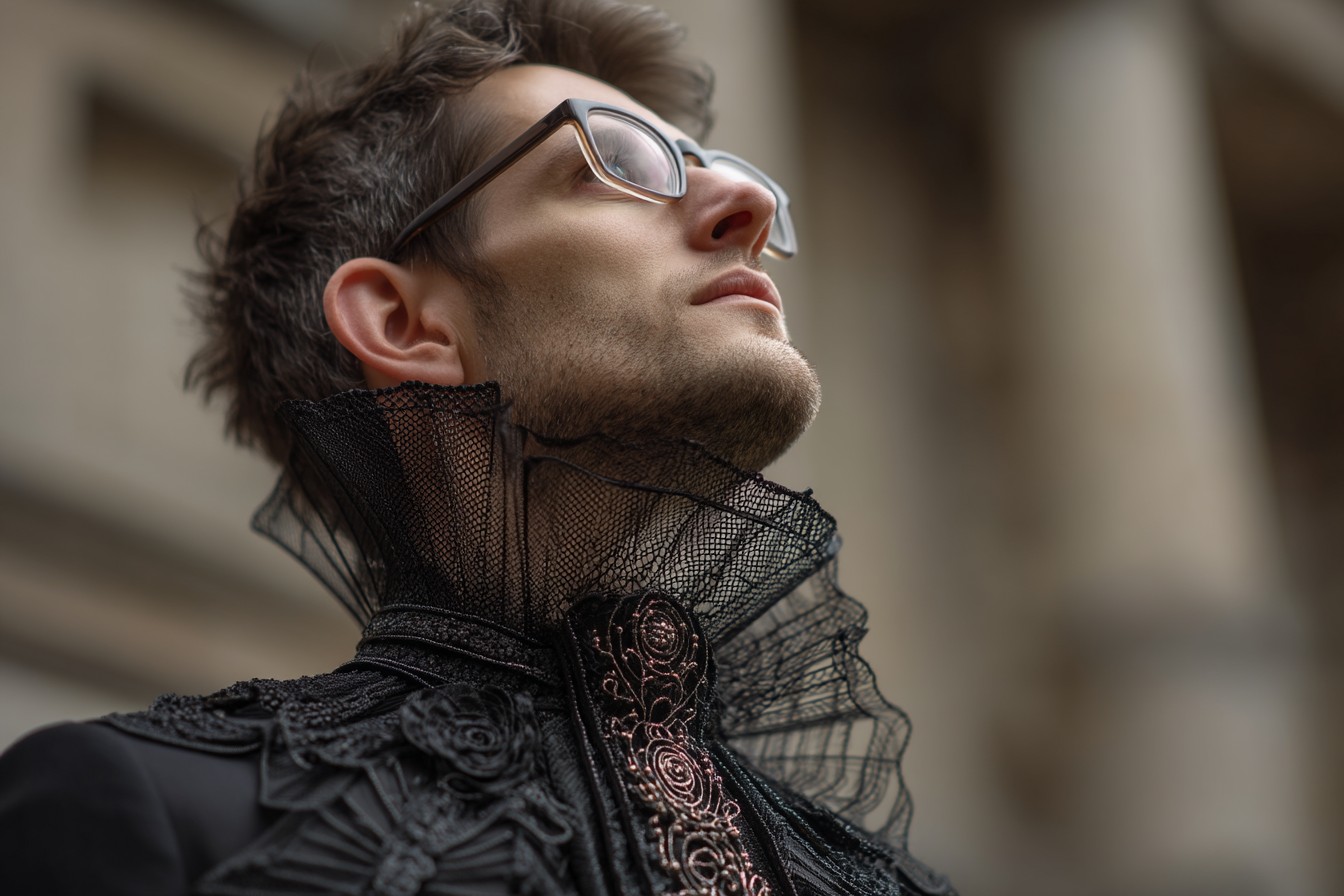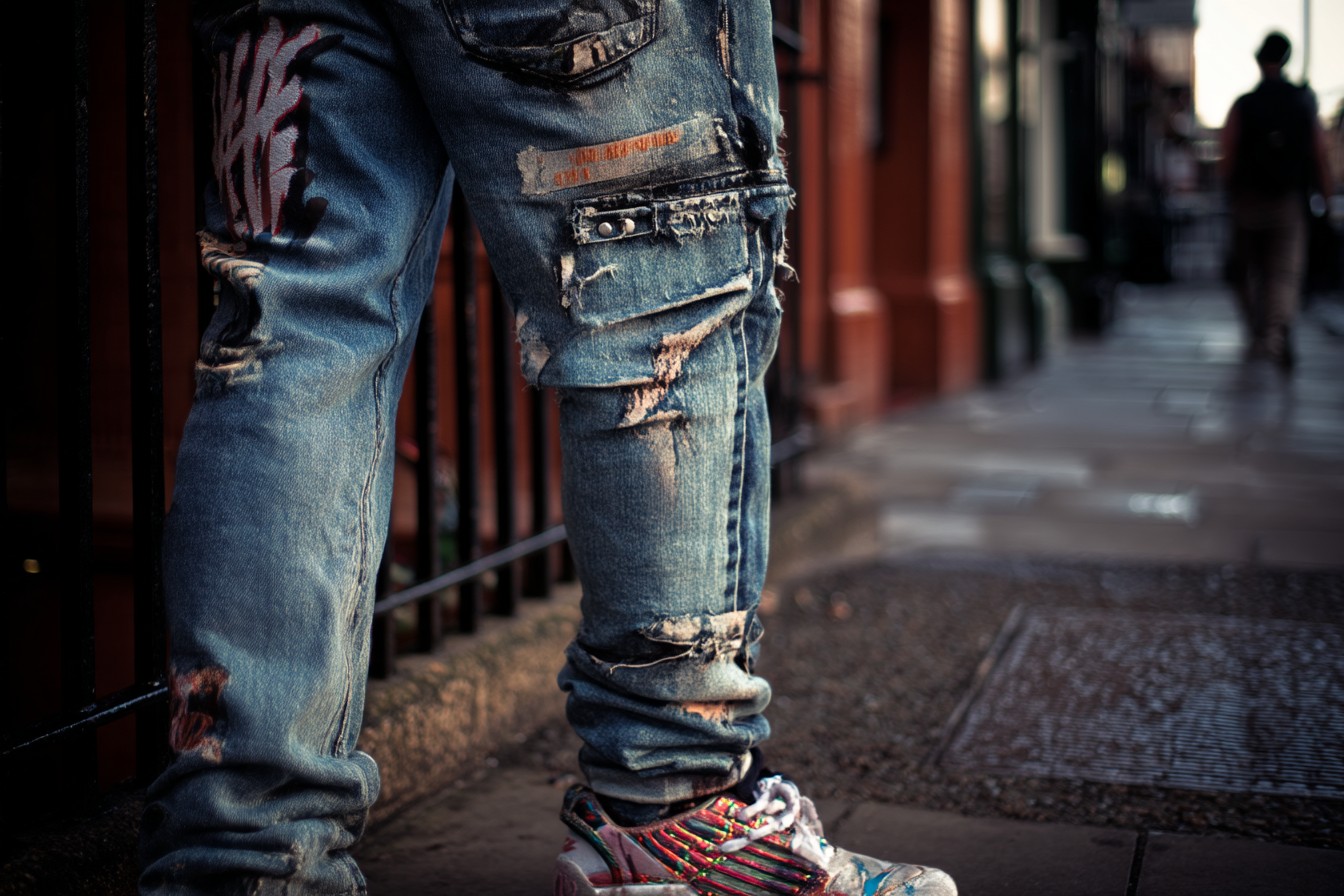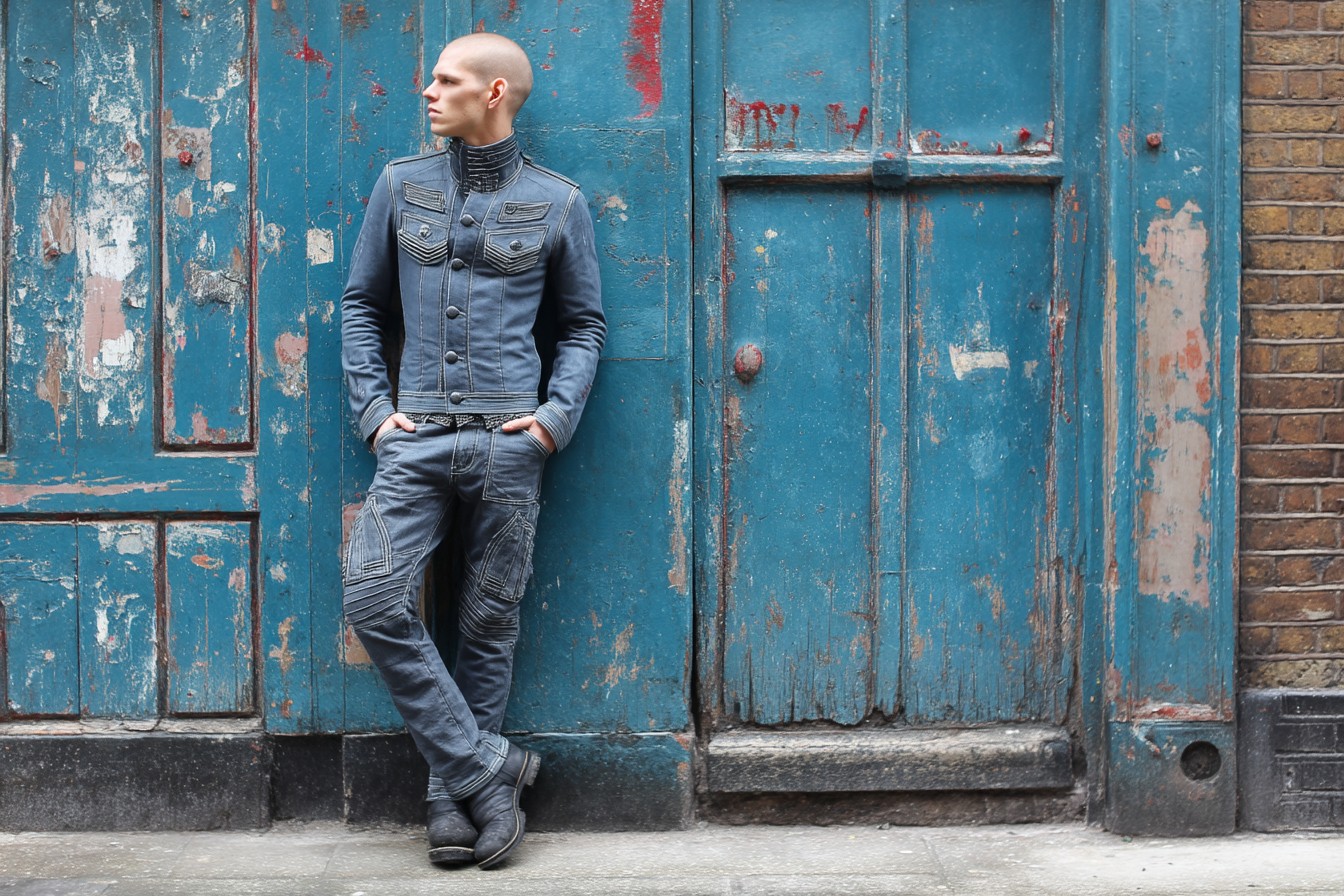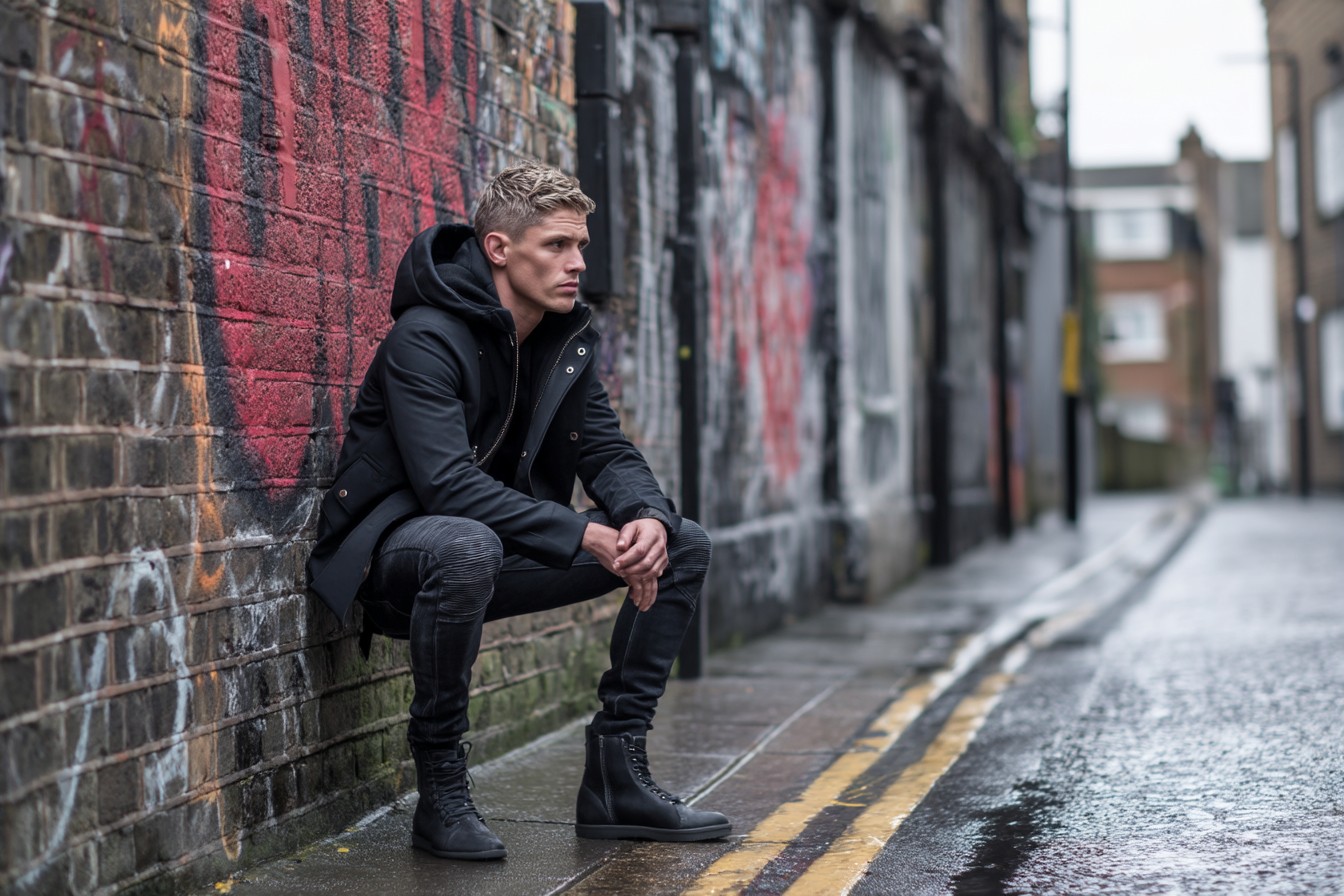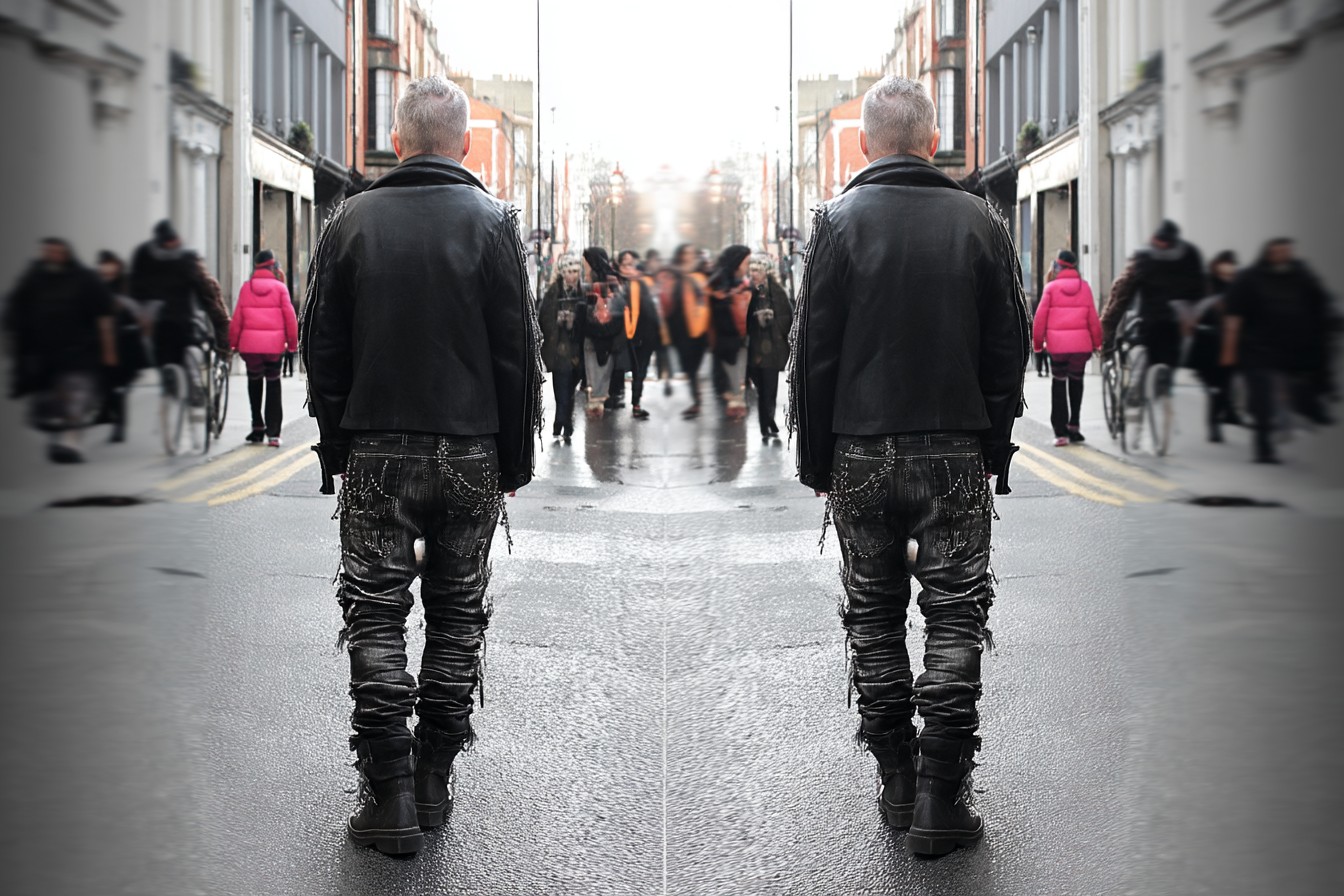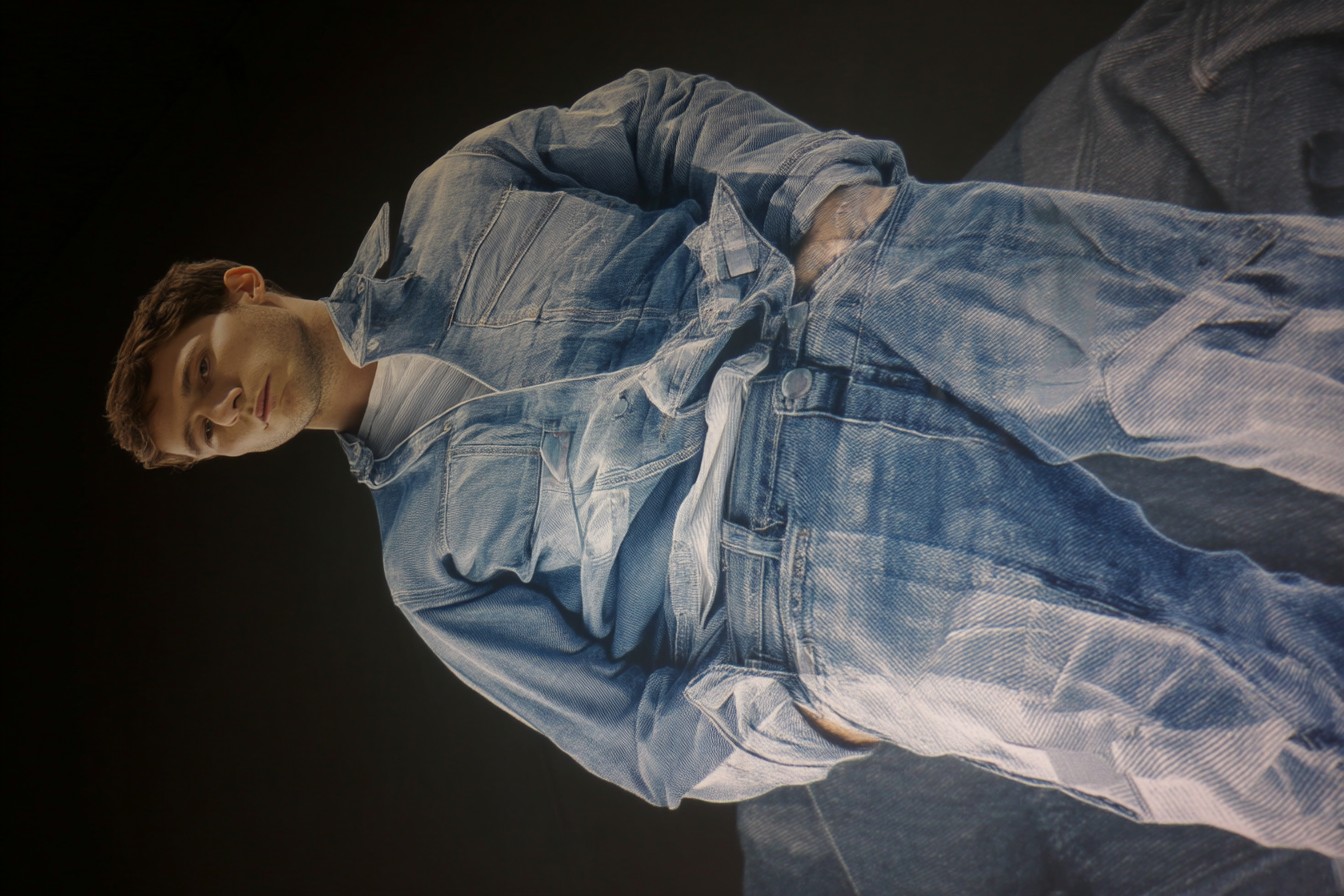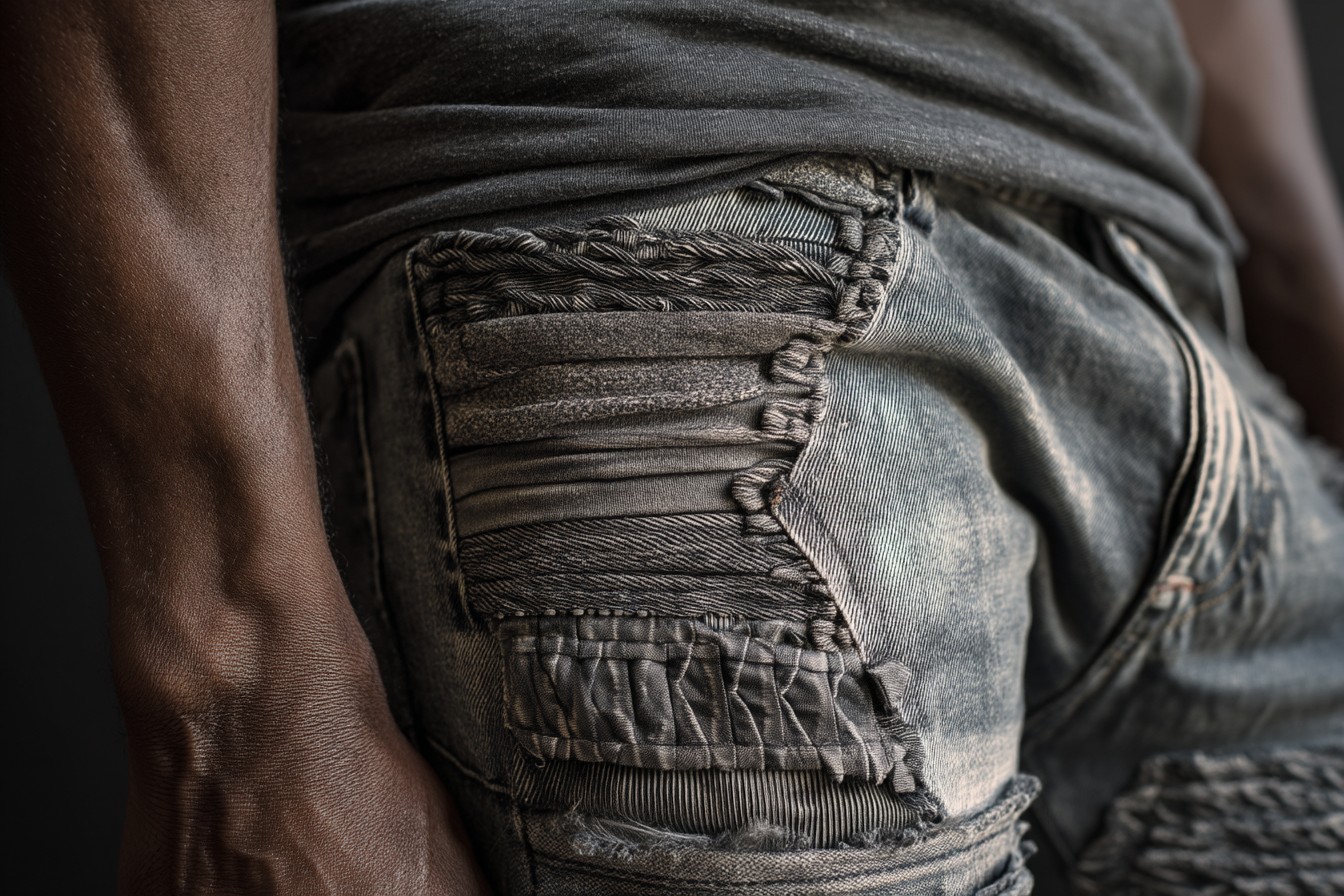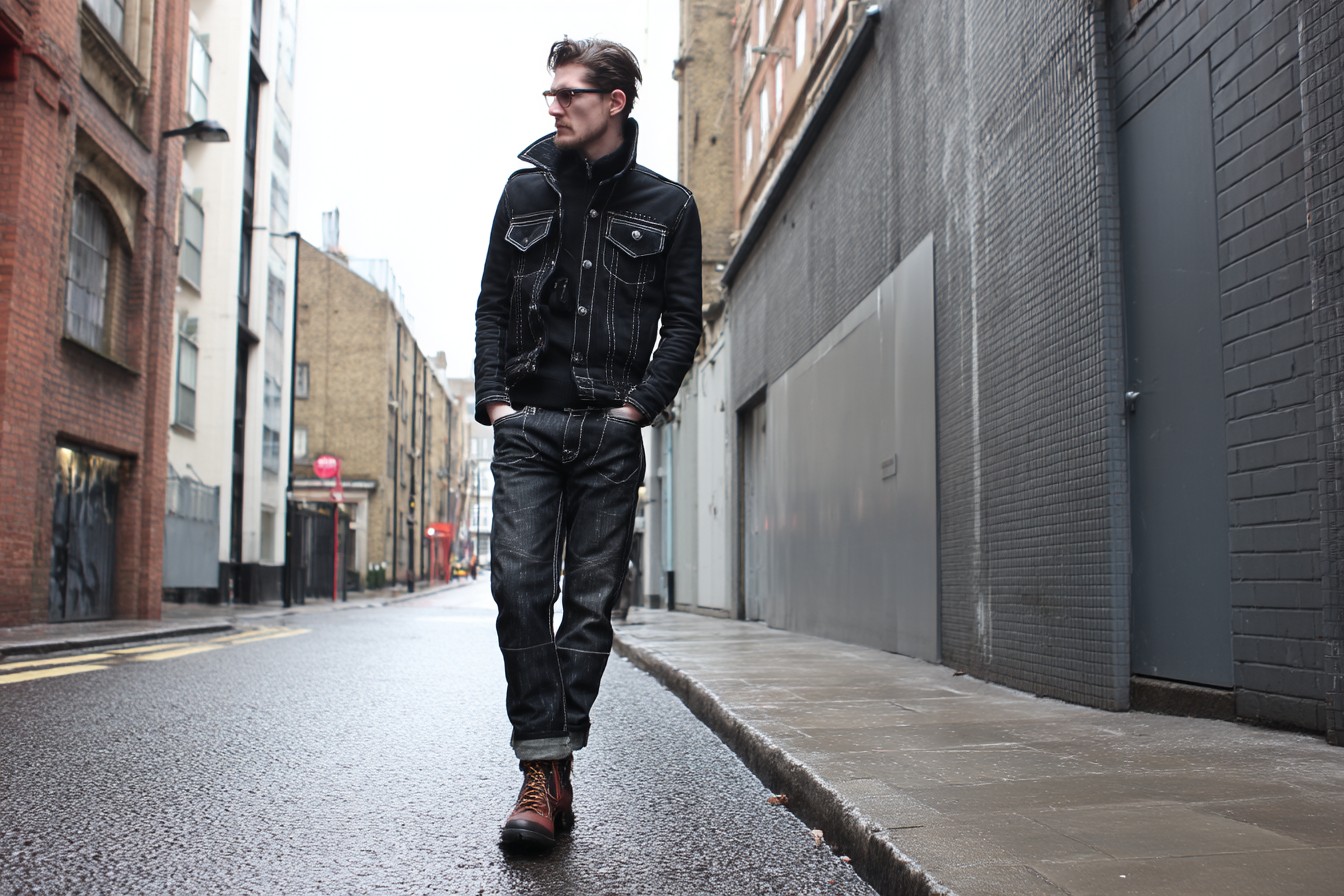“Right, you’re not wearing that.” Four words that transported me straight back to being fourteen, trying to leave the house in what I thought was a perfectly acceptable outfit for the school disco. Except I wasn’t fourteen anymore—I was thirty-nine, standing in my parents’ front room in Manchester, watching my dad eyeball my carefully selected ensemble with the kind of withering disdain usually reserved for people who put milk in before tea.

“What’s wrong with it?” I asked, looking down at my outfit—a navy knitted polo, Japanese selvedge denim, and what I knew for a fact were extremely tasteful Belgian loafers. Dad snorted. Actually snorted.
“You look like you’re trying too hard,” he said, in that matter-of-fact Northern way that brokers no argument. “All that money you spend on clothes and you still look like you’re playing dress-up.” And then, the kicker: “Let me sort you out for the week. Proper clothes. Man’s clothes.”
Which is how I—a professional style journalist who literally gets paid to have opinions about menswear—ended up agreeing to let my 72-year-old father from Stockport, a man whose idea of “dressing up” is putting on a shirt with actual buttons, dictate my wardrobe for an entire week. Including, God help me, for a meeting with the editor of GQ.

For context, my dad worked as an accountant for forty years. His style philosophy can be summarized as “if it’s not broken, why would you replace it?” He owns exactly three suits (funeral, wedding, interview), five shirts (all white or blue), and an impressive collection of jumpers that have survived longer than most of my relationships. He still has shoes older than me, which he proudly takes to the same cobbler twice a year for “maintenance.” His concessions to modern style begin and end with owning a pair of what he calls “those funny Japanese jeans” that I gave him four Christmases ago.
Day one of the experiment dawned with Dad presenting me with my first outfit: dark Levi’s 501s (straight leg, definitely not slim), a crisp white shirt (“top button undone, I’m not a monster”), a navy lambswool V-neck jumper, and brown brogues that he assured me were “proper leather, none of that glued rubbish.” The finishing touch was his pride and joy—a Barbour waxed jacket that’s been with him since the early 90s, re-waxed and patched so many times it’s practically a family heirloom.
“This,” he announced with absolute certainty, “is how a man dresses.”

I felt like I’d stepped into a time machine set to 1985. The jeans were roomier than anything I’d worn in a decade. The jumper was actually quite nice (Marks & Spencer’s finest) but at least two sizes larger than I’d normally choose. And the Barbour—a classic, sure, but about as far from my usual tailored aesthetic as you could get.
“You look dead smart,” Mum chimed in, before adding what might be the most Northern compliment ever: “Very sensible.”
I had a breakfast meeting with a PR contact at a trendy spot in the Northern Quarter. Ellie, who’s used to seeing me in everything from obscure Japanese designers to vintage Americana, did a double-take as I approached the table.

“Wow, you look…” she paused, clearly searching for the right word, “…practical!” She wasn’t wrong. I looked like I could happily fix a fence and then pop to the pub without changing. The weird thing was, I felt strangely comfortable. Those 501s had more freedom of movement than my usual Japanese selvedge skinny jeans. The Barbour, once I got over the country squire associations, was genuinely perfect for Manchester’s perpetually drizzly weather.
My usual uniform involves at least some kind of statement piece—an unusual fabric, an interesting cut, something that signals fashion literacy. Dad’s outfit signaled nothing except “I am a man who does not want to be cold or wet, and might need to change a tire later.” There was something weirdly liberating about that.
Day two brought what Dad called his “smart casual” option: checked button-down shirt from Charles Tyrwhitt (“bought in the sale, four for £100, absolute bargain”), corduroy trousers in dark green, and those same brown brogues. For outerwear, a waxed cotton Harrington jacket that he’d had since I was in primary school.

“The check adds personality,” he told me seriously, as if imparting great wisdom. “But nothing too daft.”
I had an afternoon of writing at home followed by drinks with mates. Jamie, who knows me well enough to spot something amiss, texted me when I was twenty minutes late to the pub: “Are you actually coming or what?” When I walked in, he stared at me like I’d grown a second head.
“What the actual fuck are you wearing? You look like someone’s uncle at a christening.”

“It’s an experiment,” I explained, ordering a pint with as much dignity as I could muster. “Dad’s styling me for a week.”
“Ah,” he nodded sagely. “That explains the cords. They’re actually not bad, you know.”
The bartender, who usually completely ignores me, actually made eye contact and asked how my day was going. A woman at the end of the bar struck up a conversation about whether it might rain later. It was like I’d suddenly become approachable. Visible in a completely different way.

By day three, I was actually curious to see what Dad would produce. The answer: an oatmeal lambswool jumper (“not beige, oatmeal”), the same 501s, and—plot twist—desert boots. “I’m not totally stuck in the past,” he said, almost offended at my surprise. “These are timeless. Steve McQueen wore them.”
I recognized the desert boots immediately as the pair I’d bought him three birthdays ago, barely worn. When I pointed this out, he shrugged. “Saving them for good. Today’s good.”
I had to meet with a designer about a potential collaboration—a meeting where I’d normally dress to display my fashion credentials. Instead, I looked like I might be about to help someone move house. The designer, an avant-garde type who typically wears architectural black layers, looked at me with genuine confusion.

“Are you okay?” she asked, concern in her voice. “Has something happened?”
I explained the experiment, which she found absolutely hilarious. “Your dad’s a genius,” she declared. “This is normcore taken to authentic extremes. It’s actually quite refreshing.”
I wasn’t sure whether to be flattered or offended on Dad’s behalf. He wasn’t trying to be normcore—he was just being normal. But she was right about one thing—there was something refreshing about the complete lack of fashion anxiety in his choices. Every item was selected purely on merit: Will it keep you warm? Will it last? Is it comfortable? Does it do the job it’s meant to do? No concerns about trends, statements, or what message it might be sending.

Day four coincided with a meeting at GQ that couldn’t be rescheduled. I was genuinely nervous about what Dad might select for this fashion crucible. To my surprise, he produced the most on-trend outfit of the week: a denim shirt (“proper thick one, not that thin rubbish”), dark jeans, and a tweed sports jacket that wouldn’t have looked out of place at Pitti Uomo.
“This is…actually quite fashionable,” I admitted, impressed despite myself.
Dad looked horrified. “It’s not fashionable,” he corrected me sternly. “It’s classic. Different thing entirely.”

The jacket, it turned out, was older than me—purchased in 1982 from a proper tailor in Manchester city center. It had the kind of patina and character that fashion brands spend fortunes trying to replicate. The denim shirt was Levi’s, possibly from around the same era. None of it was trying to be trendy, yet somehow it all felt current.
My editor actually complimented the jacket, asking if it was vintage RRL or possibly a new Drake’s piece. When I explained it was my dad’s from the early 80s, he nodded appreciatively. “That’s the real deal. You couldn’t buy that authenticity.”
Day five brought the most surprising outfit: black jeans, a plain black t-shirt, cherry-red Dr. Martens that I recognized as mine from university (how did they end up in his wardrobe?), and a black leather jacket.

“Dad,” I said slowly, “you own a leather jacket?”
He looked almost embarrassed. “Your mum bought it for me in 1978. Used to wear it to the pub.” He paused, a faraway look in his eyes. “I was pretty cool once, you know.”
The jacket was perfect—not the expensive designer versions I’d bought and sold over the years, but an actual, honest-to-god biker jacket worn by an actual person over actual decades. It had stories in every scuff. Mum appeared in the doorway, smiling fondly.

“He wore that when we first met,” she said. “Thought he was the business.”
I had dinner plans with an ex who I’m still friendly with. Sophie did a literal double-take when I walked into the restaurant.
“Bloody hell,” she said, “you look hot. Like, actually hot, not fashion-hot.”

I wasn’t entirely sure what “fashion-hot” meant or whether I should be insulted, but the leather jacket got more compliments that evening than anything I’d worn in months. When I explained it was my dad’s from his youth, Sophie’s eyes actually softened. “That’s lovely,” she said. “Much better than those weird Japanese jackets you used to drop three months’ rent on.”
The weekend brought casual wear. Saturday was what Dad called “jobs around the house clothes” — a faded blue sweatshirt from Marks & Spencer, cargo shorts (“all those pockets are useful”), and desert boots again. Sunday was what he deemed appropriate for a family lunch: chinos, a polo shirt, and a quarter-zip lightweight jumper that he insisted was “smart enough for Sunday lunch but not stuffy.”
I felt like I’d stepped into an alternative universe where I’d never discovered fashion at all—one where practicality trumped style points every time. And yet, looking in the mirror, I didn’t hate what I saw. There was a certain unforced quality to these outfits, a lack of overthinking that felt oddly refreshing after years of calibrating every wardrobe choice.

The final day of the experiment brought what Dad called his “special occasion” outfit: a well-cut navy blazer (Anderson & Sheppard, I noted with shock, a seriously good Savile Row tailor), grey flannel trousers, a light blue button-down, and brown suede loafers.
“Where did you get this blazer?” I asked, genuinely impressed by the cut and quality.
“Your grandfather’s,” he said simply. “Had it altered to fit me in ’95. Good things last if you look after them.”

Here was the most surprising discovery of the week: beneath Dad’s practical, no-nonsense approach lay an appreciation for genuine quality and craftsmanship that aligned perfectly with my own values, just expressed differently. He didn’t care about labels or trends, but he understood instinctively the value of materials, construction, and fit.
The experiment officially over, Dad asked what I’d learned. I thought about it carefully.
“That clothes don’t have to be complicated,” I said finally. “That maybe I’ve been overthinking it.”
He nodded, satisfied. “Clothes are just clothes,” he said with Northern pragmatism. “They keep you warm and stop you getting arrested for indecent exposure. Everything else is just showing off.”
But then he paused, looking at his Anderson & Sheppard blazer hanging back in the wardrobe. “Though there’s nothing wrong with a bit of quality,” he added with a wink.
That night, packing my own clothes back into my suitcase ready to return to London, I found myself setting aside the most experimental pieces and reaching instead for the simpler items—the well-made basics, the quality classics. I even folded up Dad’s lambswool jumper, which he’d insisted I keep.
“It suits you,” he’d said gruffly, in a tone that suggested this was the highest compliment possible.
The following week, at a fashion week event in London, a street style photographer stopped me outside the venue. I was wearing 501s (albeit my own, slightly more fitted pair), a white oxford shirt, and a navy jumper—essentially Dad’s uniform, just with my own slight adjustments.
“Great look,” the photographer said. “Really authentic normcore vibe.”
I nearly told him it wasn’t normcore—it was just normal. But instead, I thought of Dad and smiled. “Thanks,” I said. “My styling consultant has very strong opinions about quality basics.”
Later that day, I sent Dad a text with a photo of my outfit. His reply came back an hour later: “Jumper looks a bit thin. You’ll catch your death.”
Some lessons never stick. But others—about quality, longevity, and not overthinking every wardrobe choice—might just be transforming my approach to style. Don’t tell Dad, but he might have been right all along. Not about the jumper thickness—I stand by my fine-gauge merino—but about the essence of good dressing: Find what works, stick with it, buy the best you can afford, and keep it forever.
Turns out you can go home again—and sometimes, your dad really does know best. Even if I’ll never admit that to his face.


